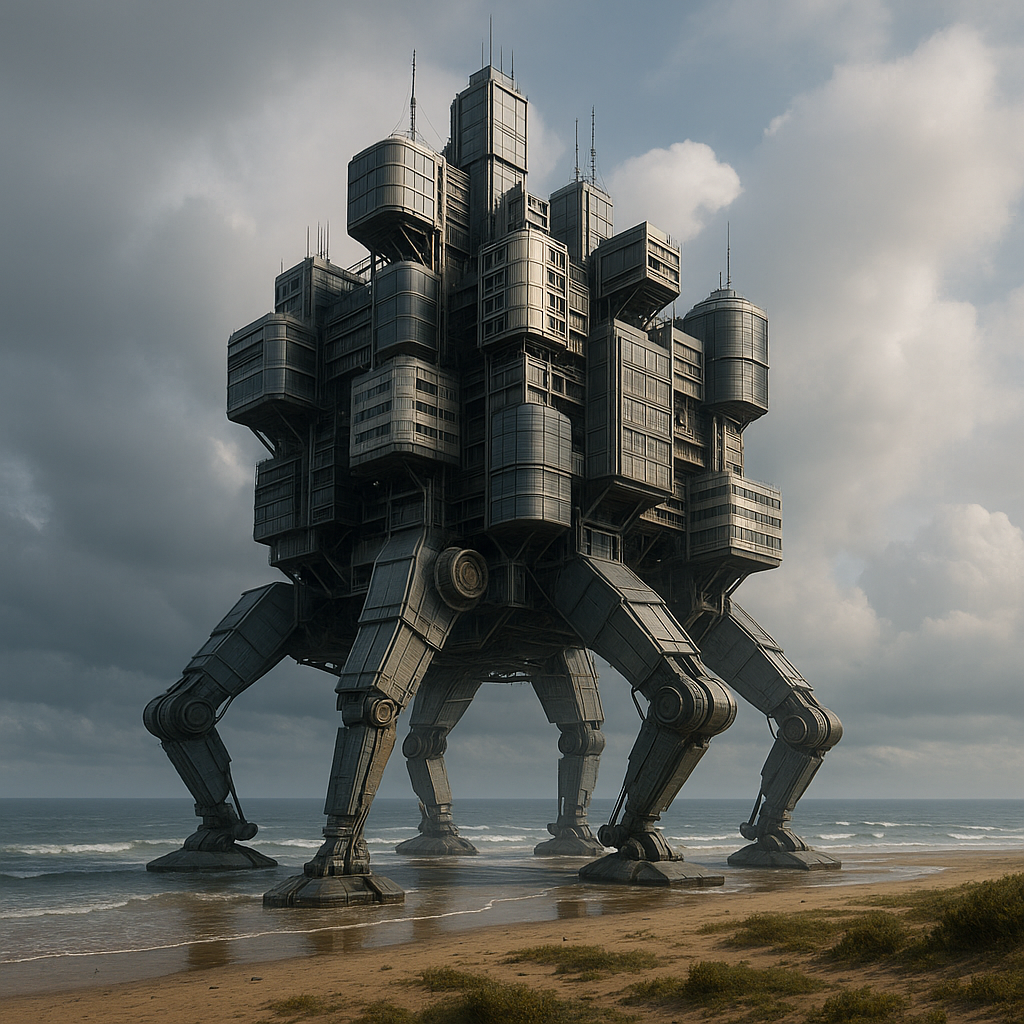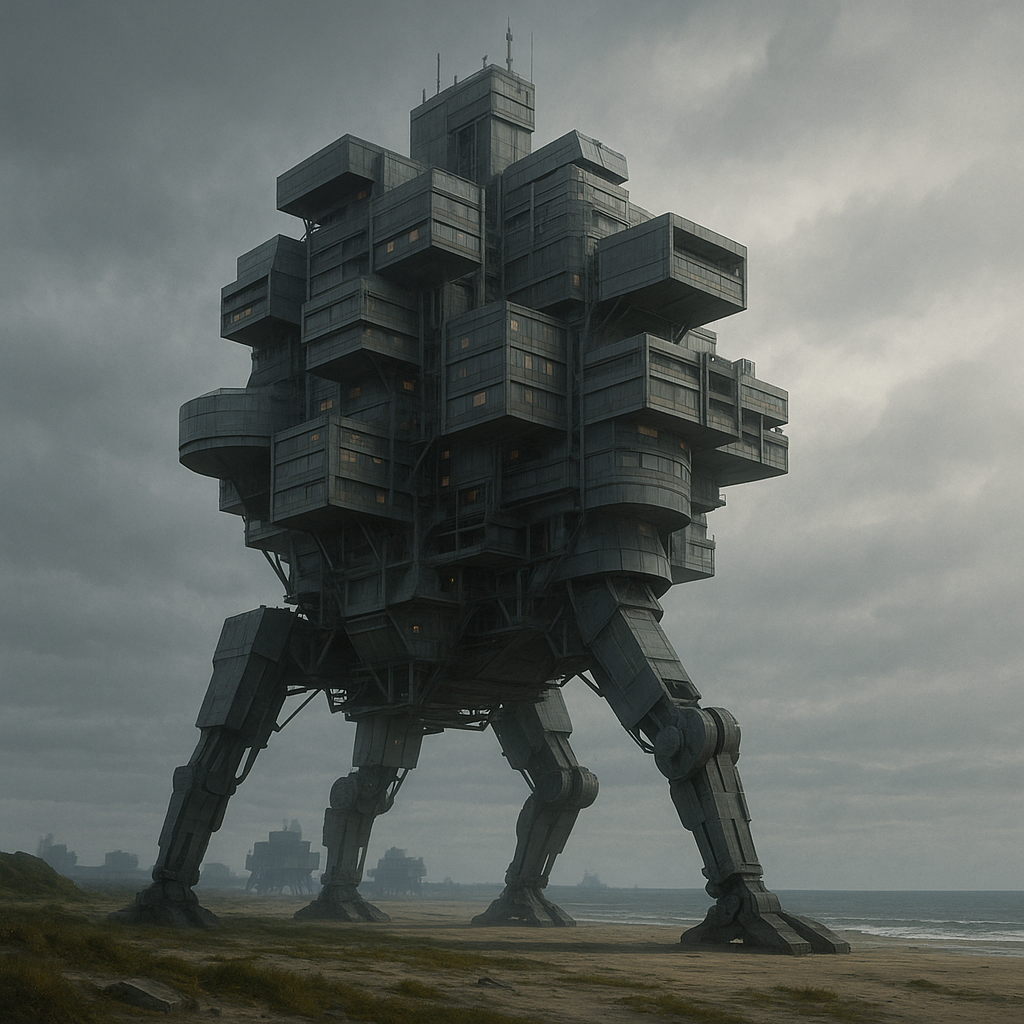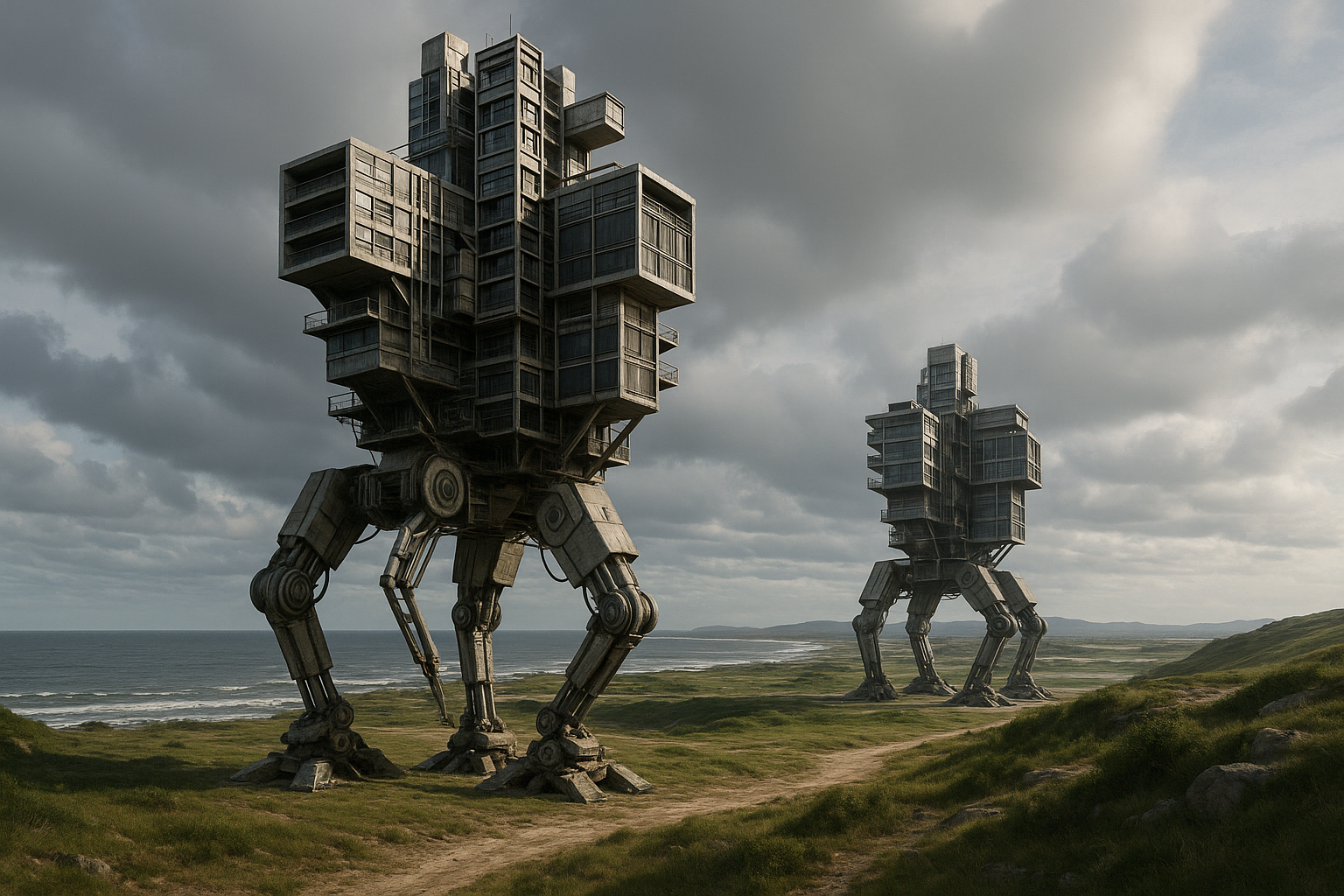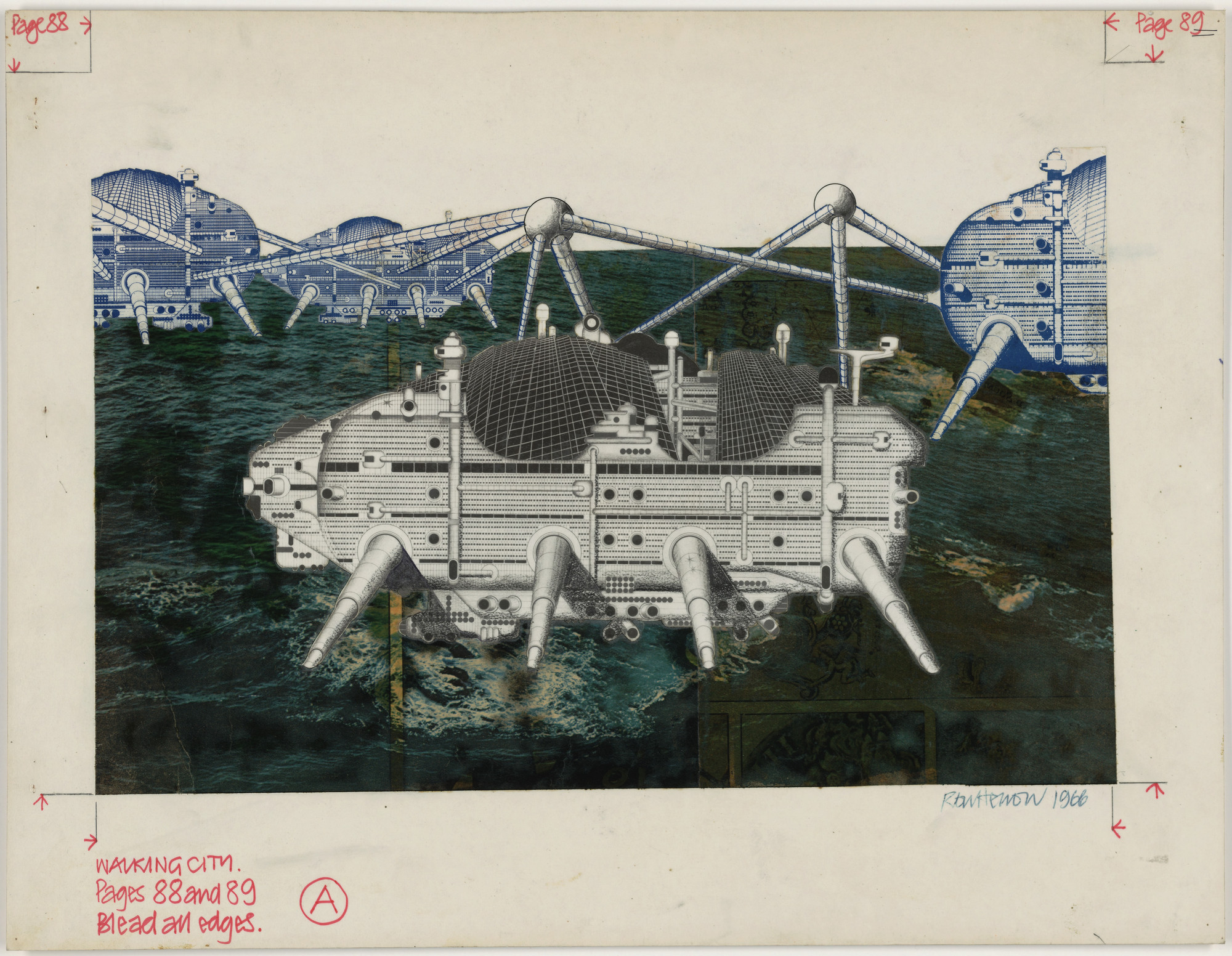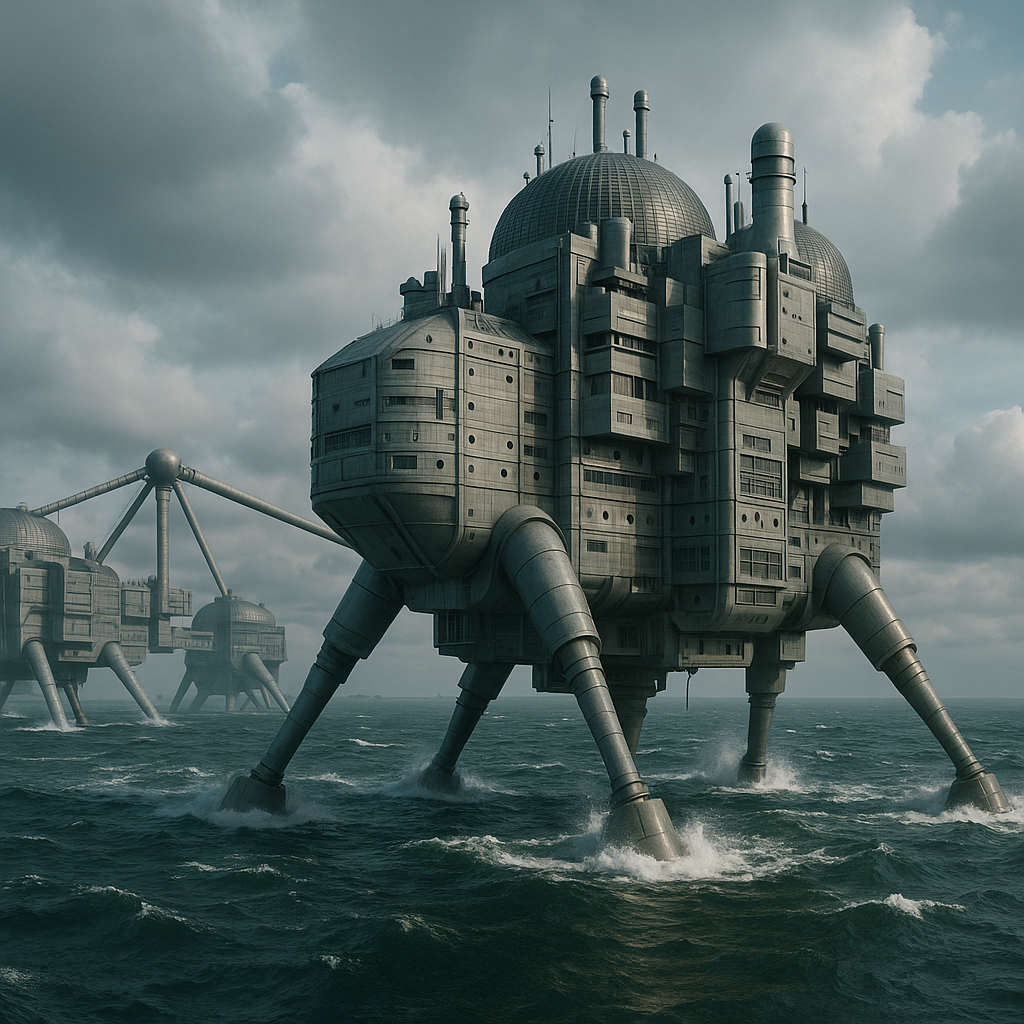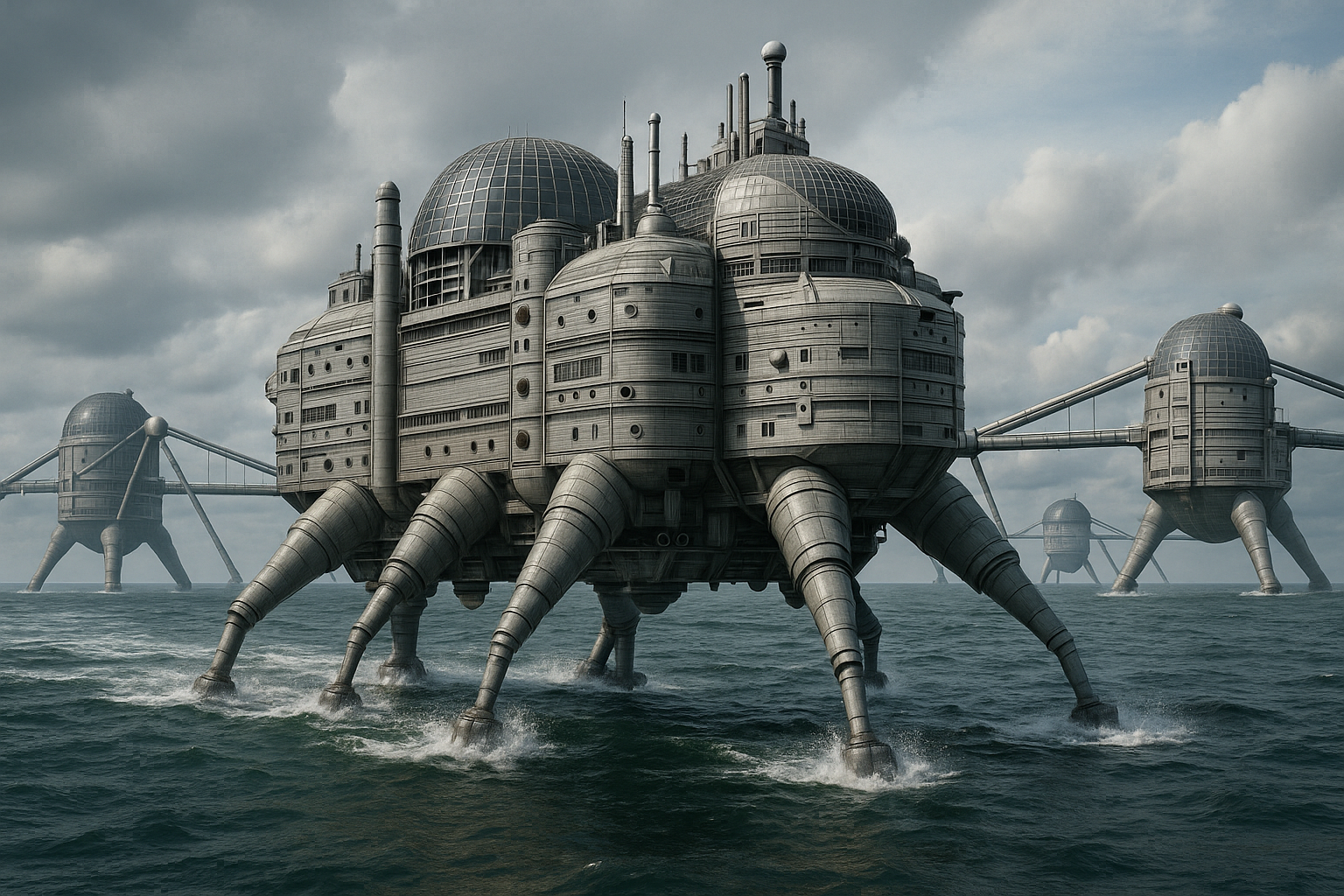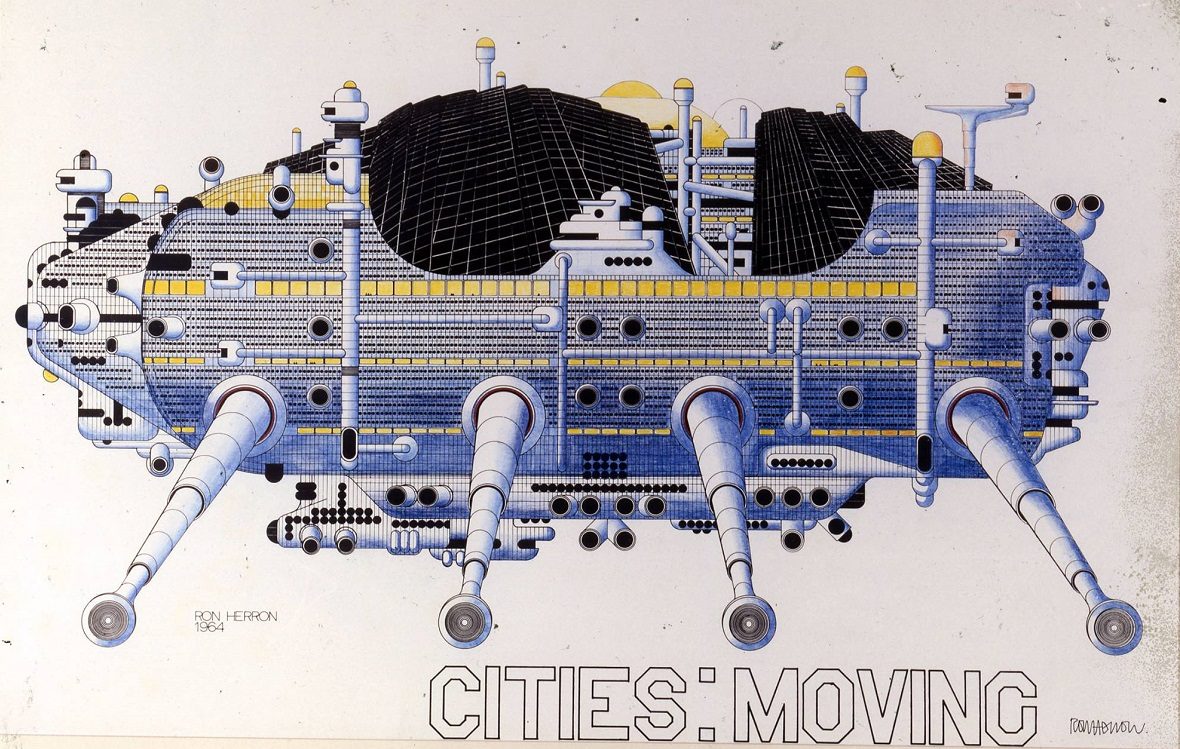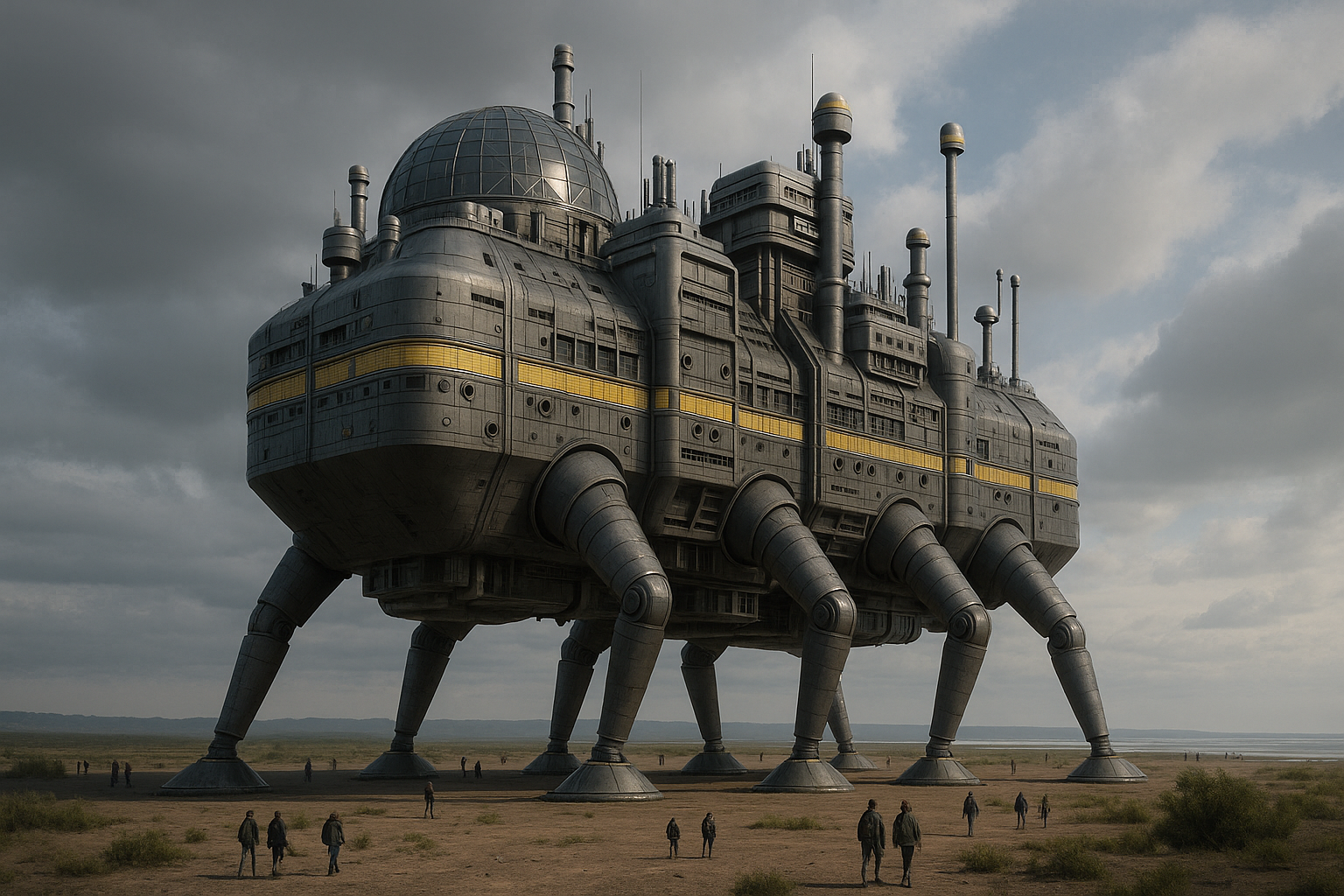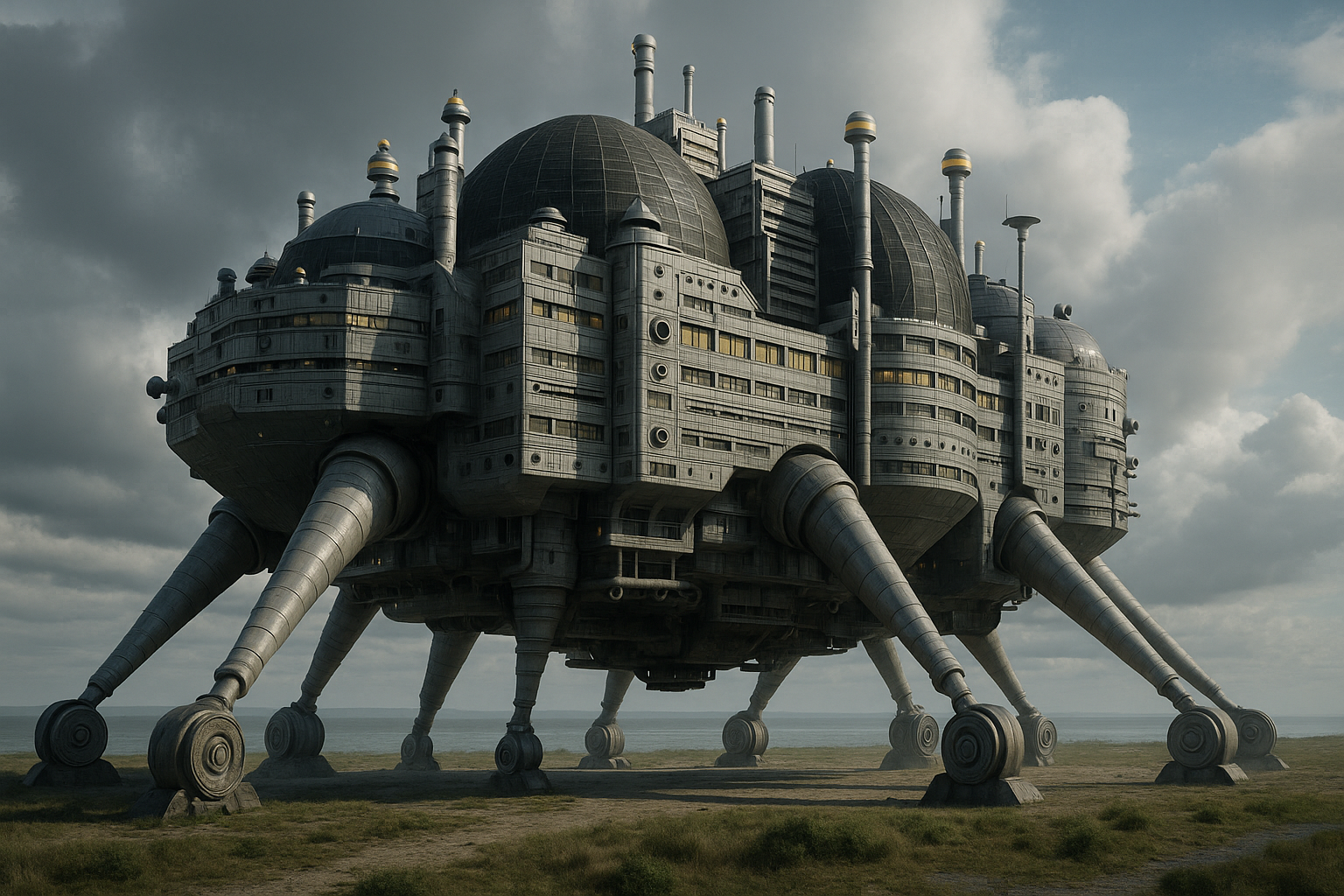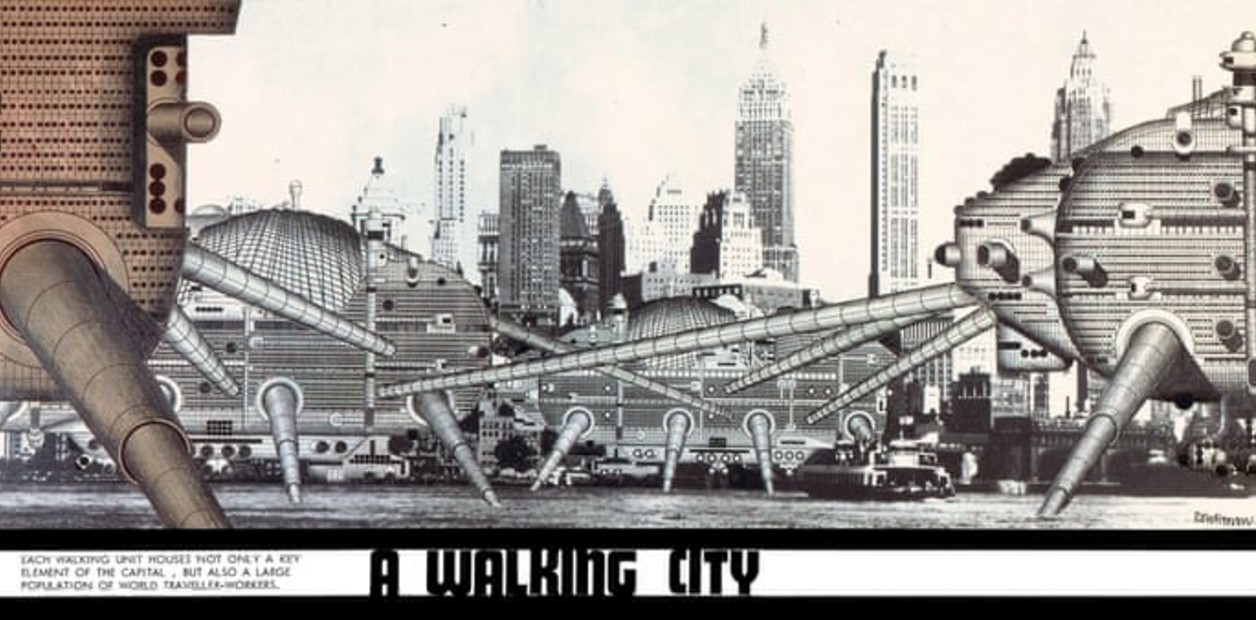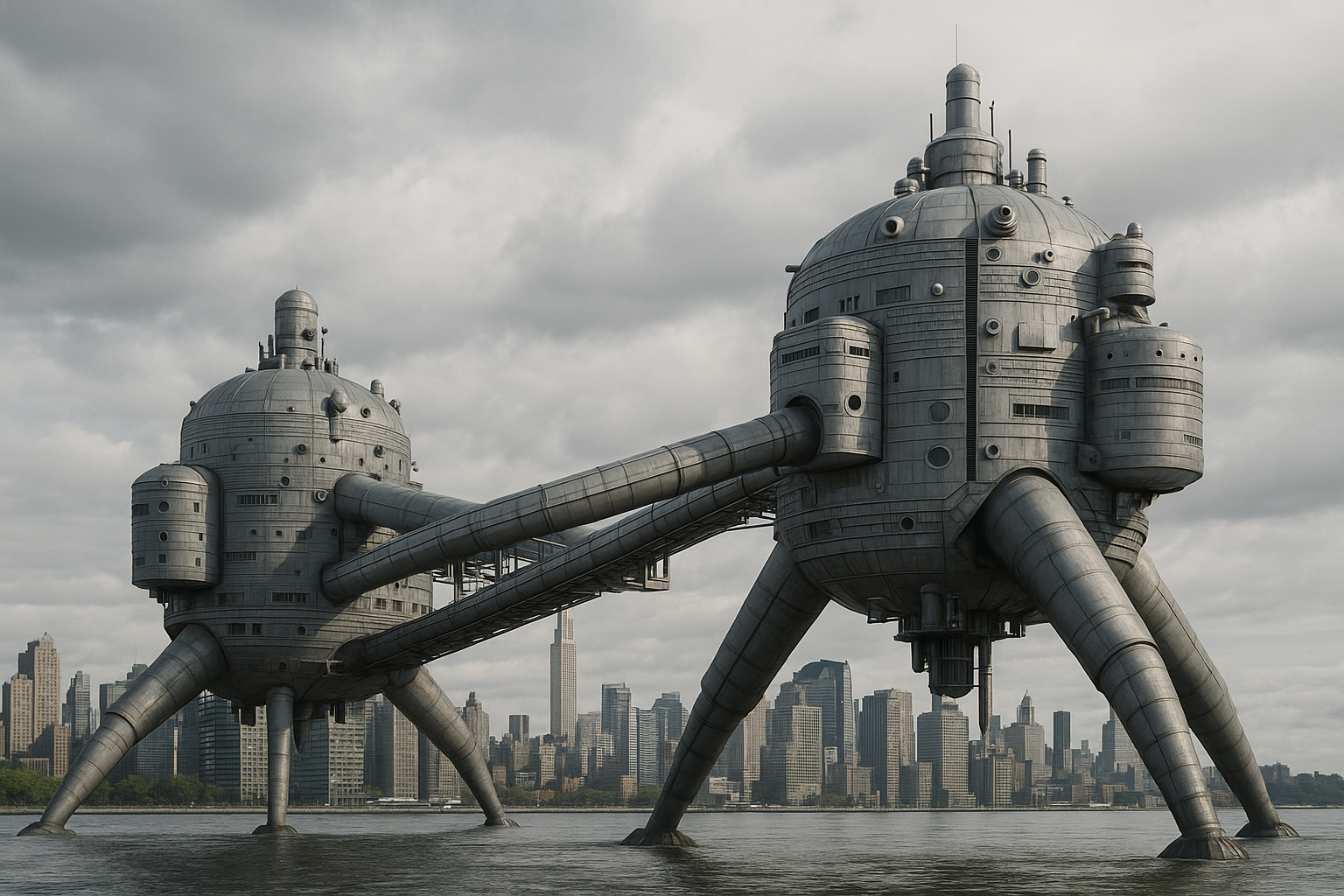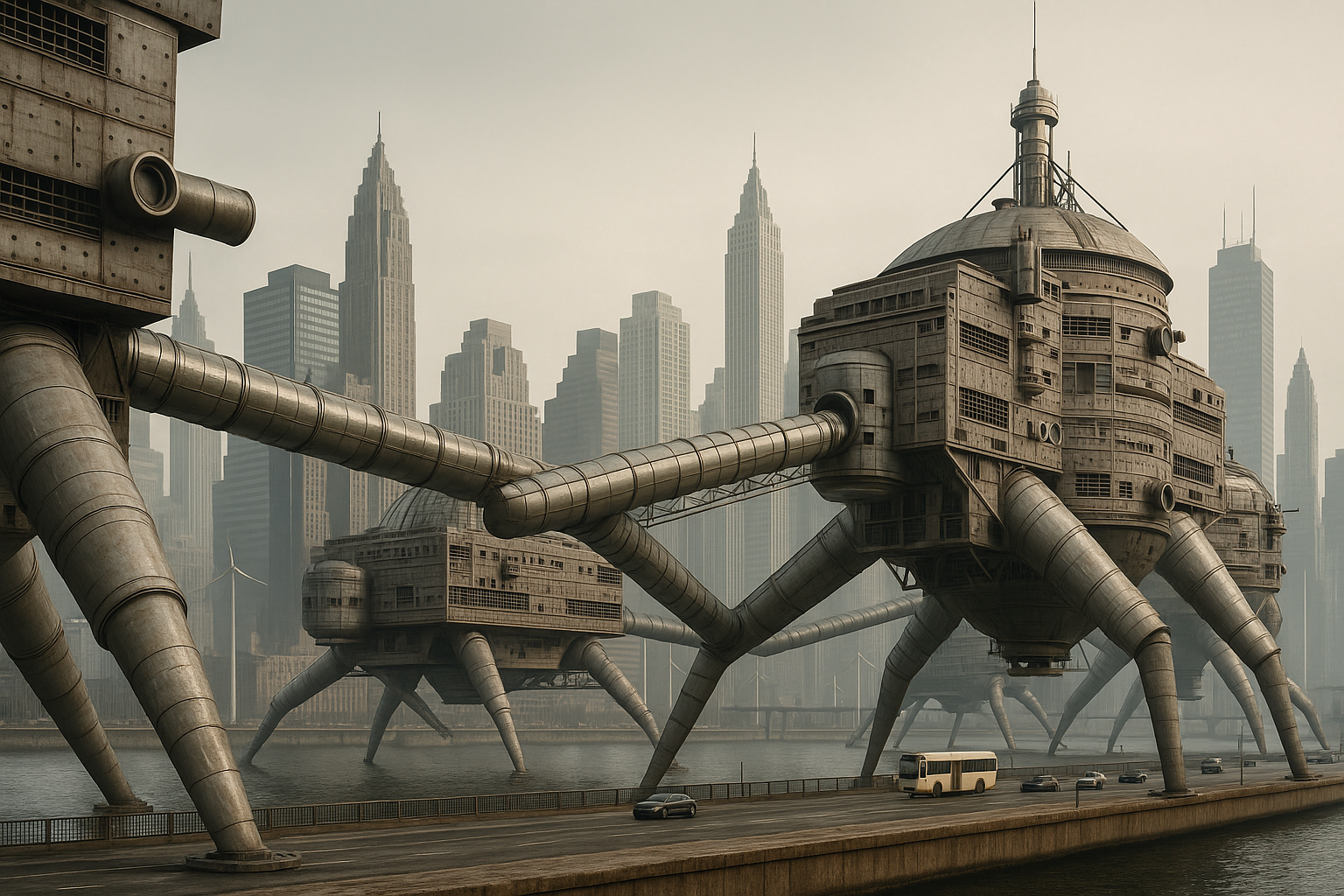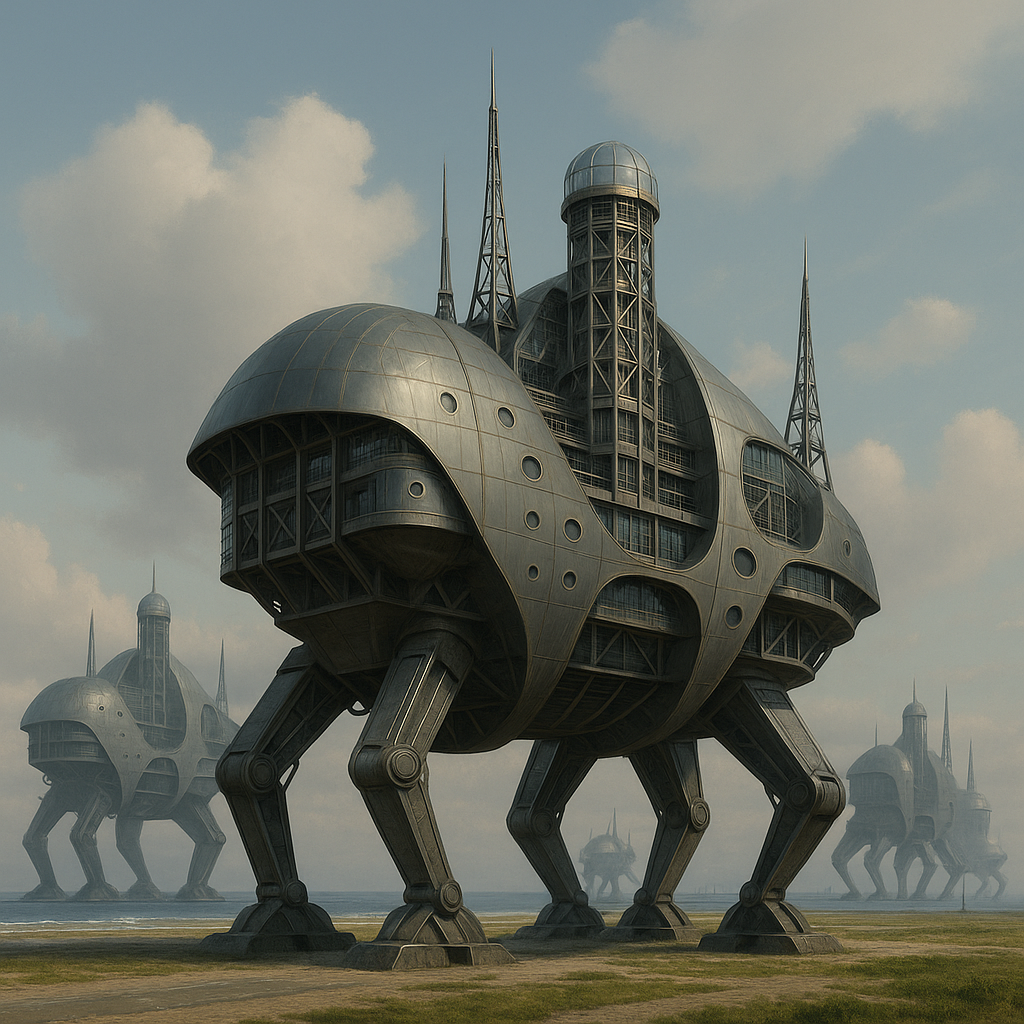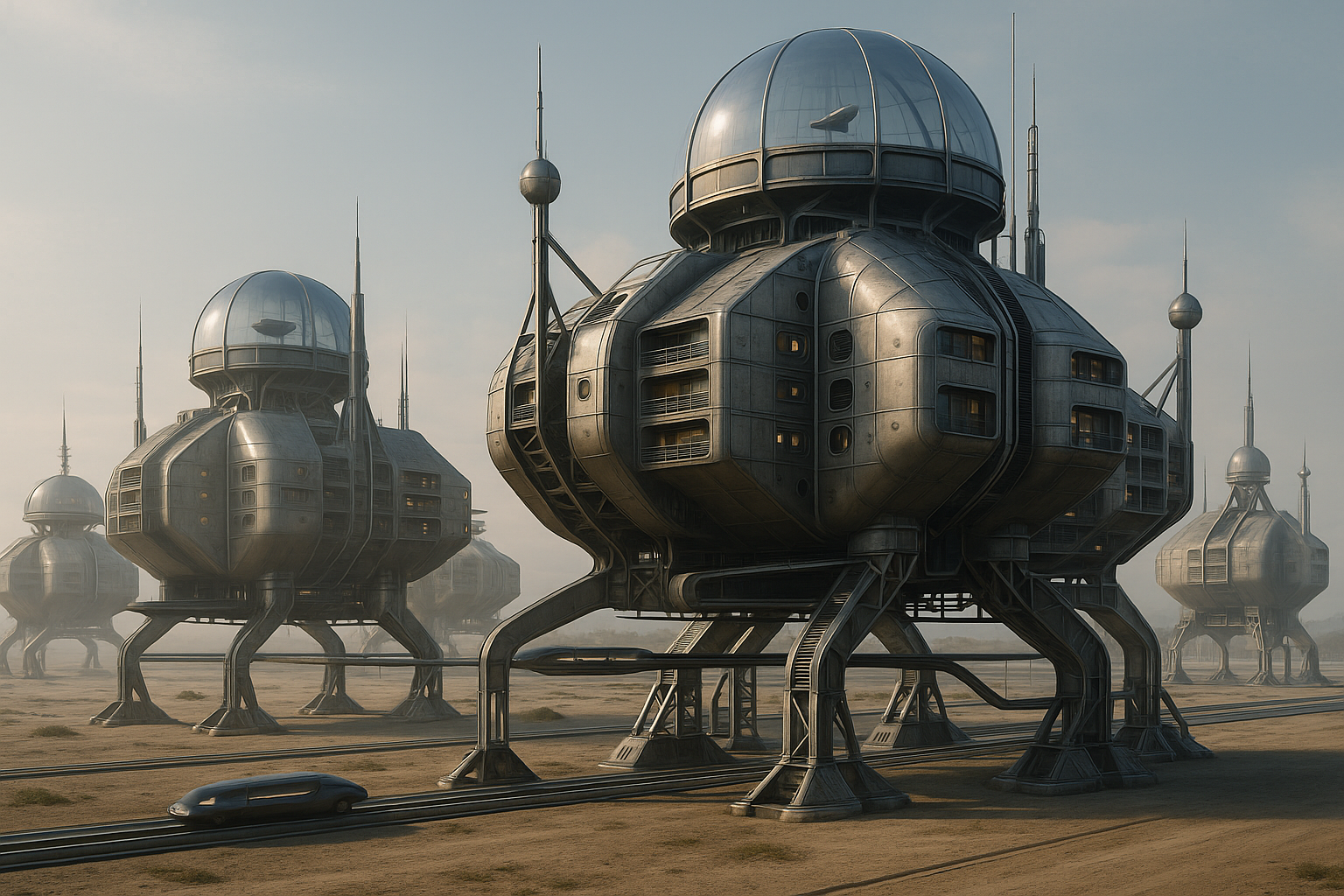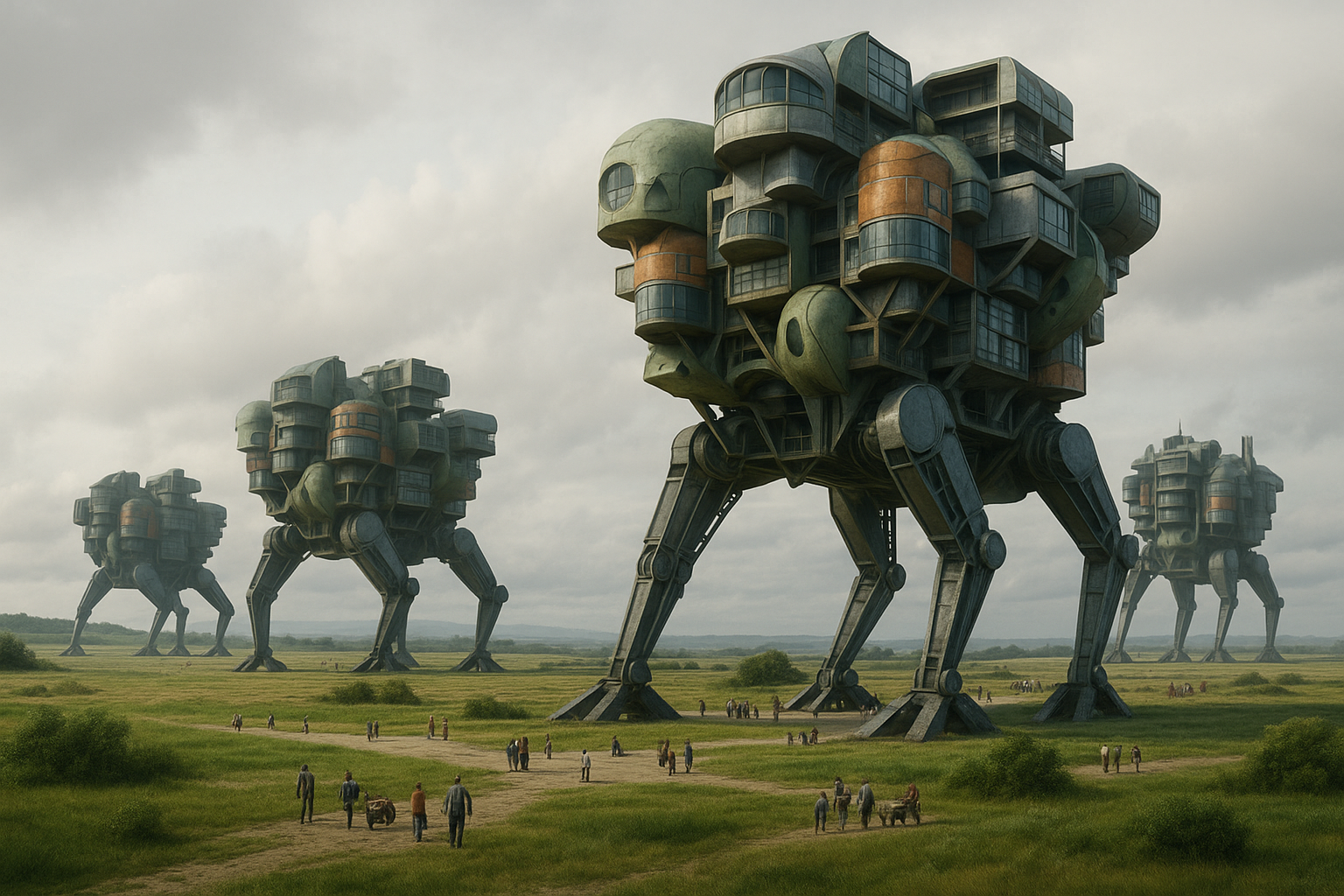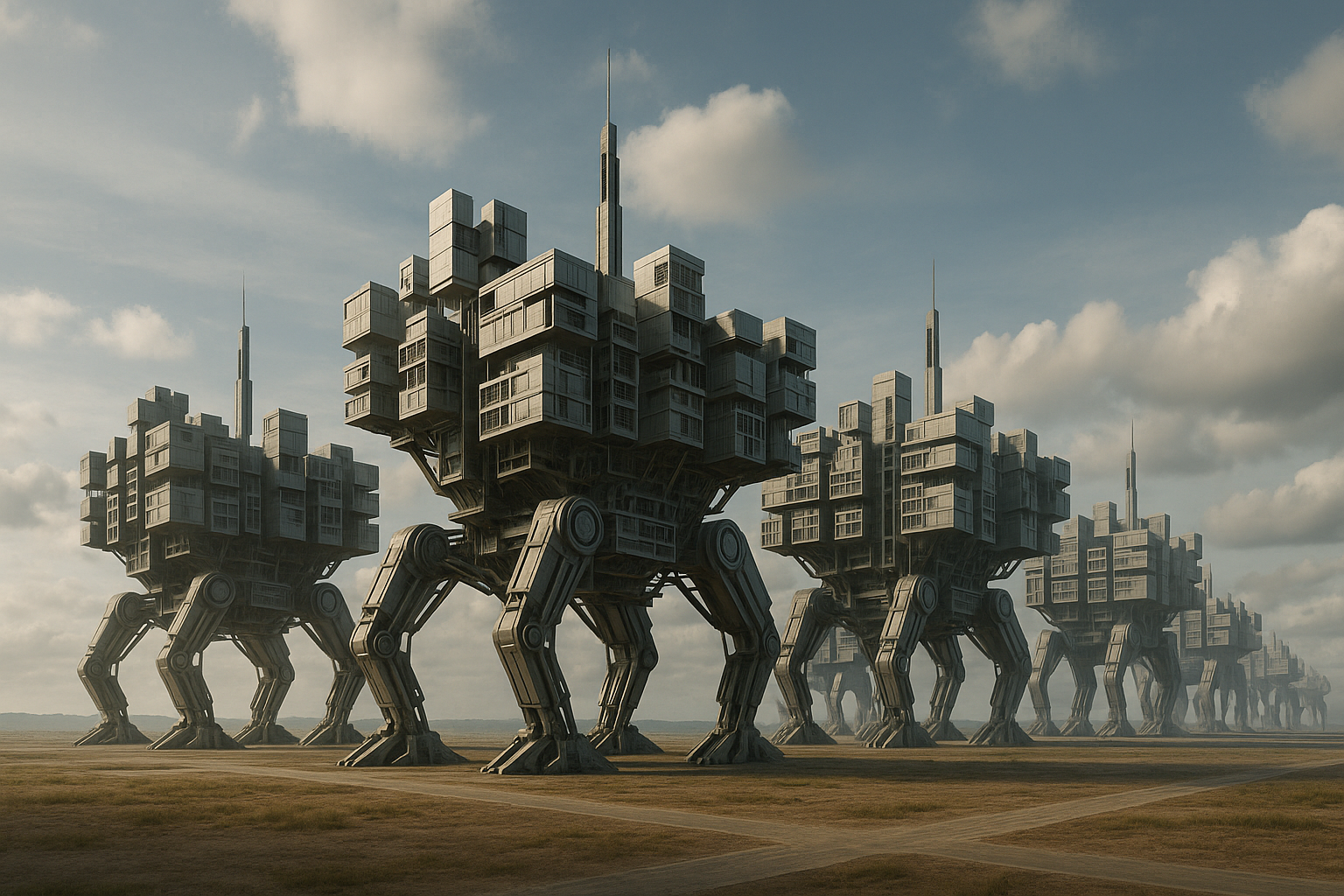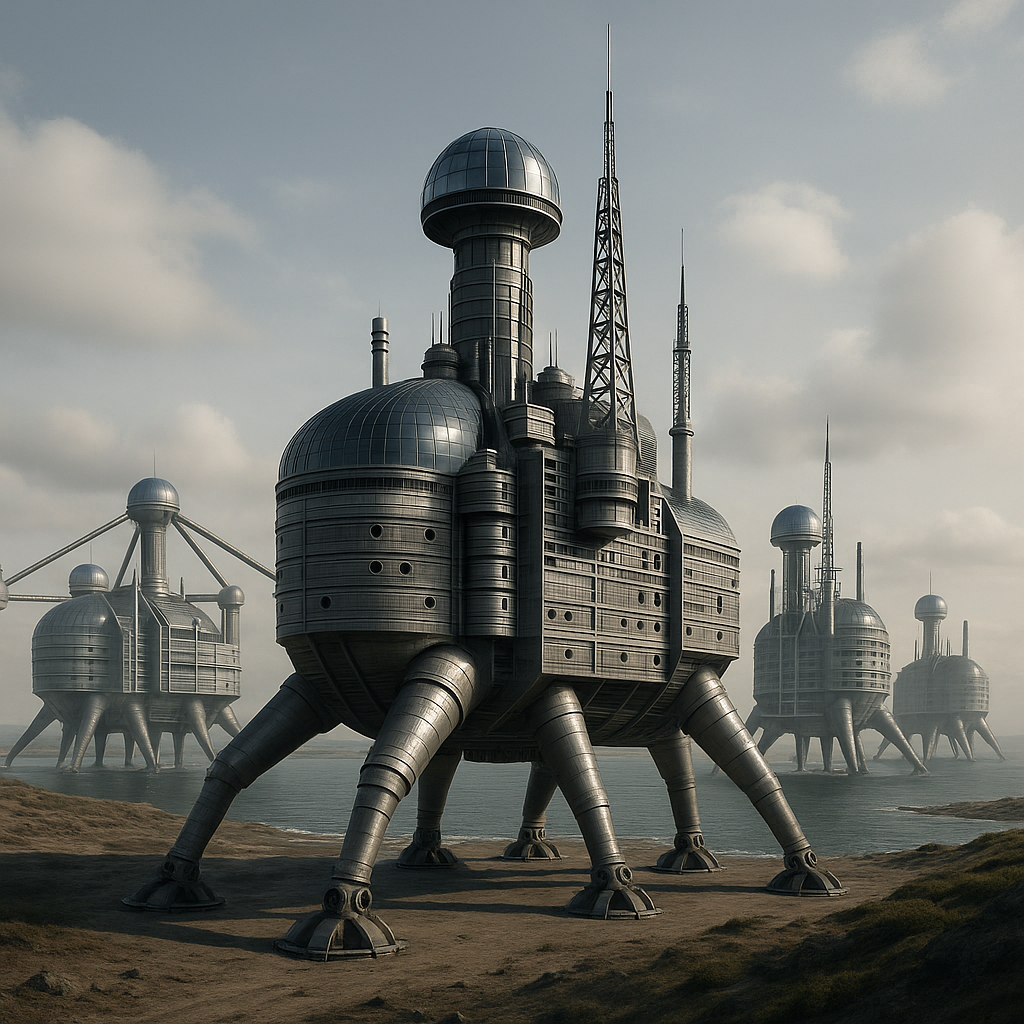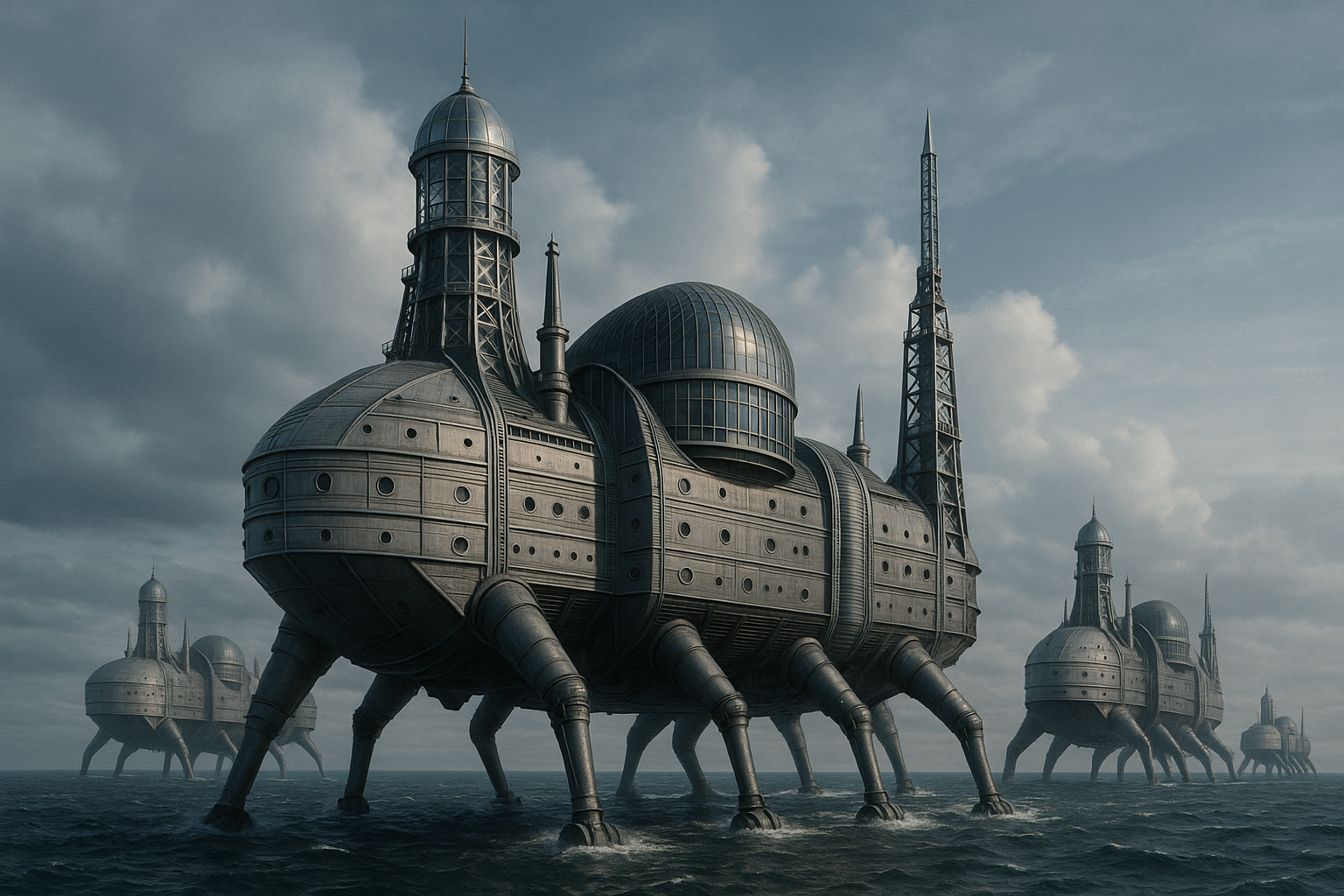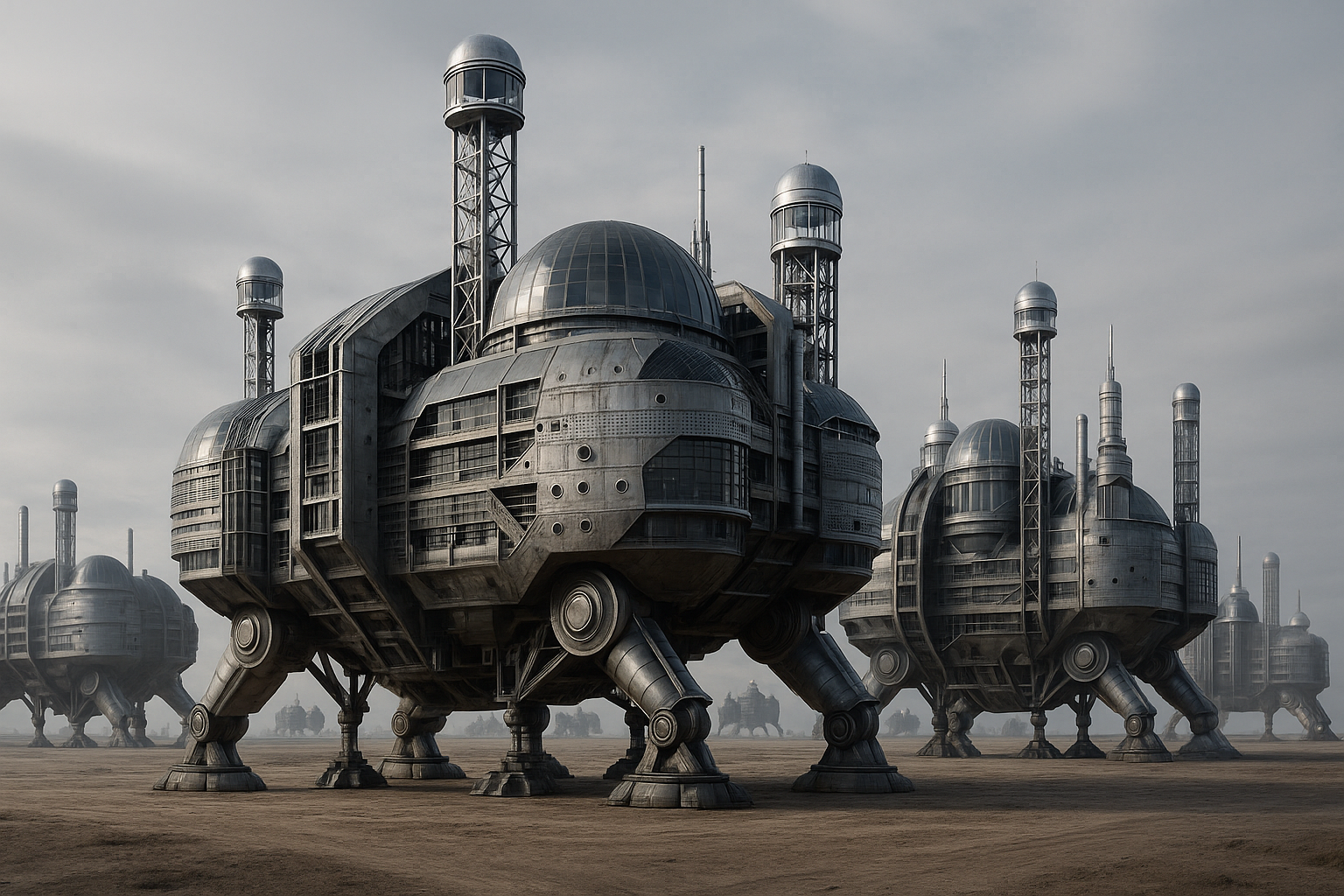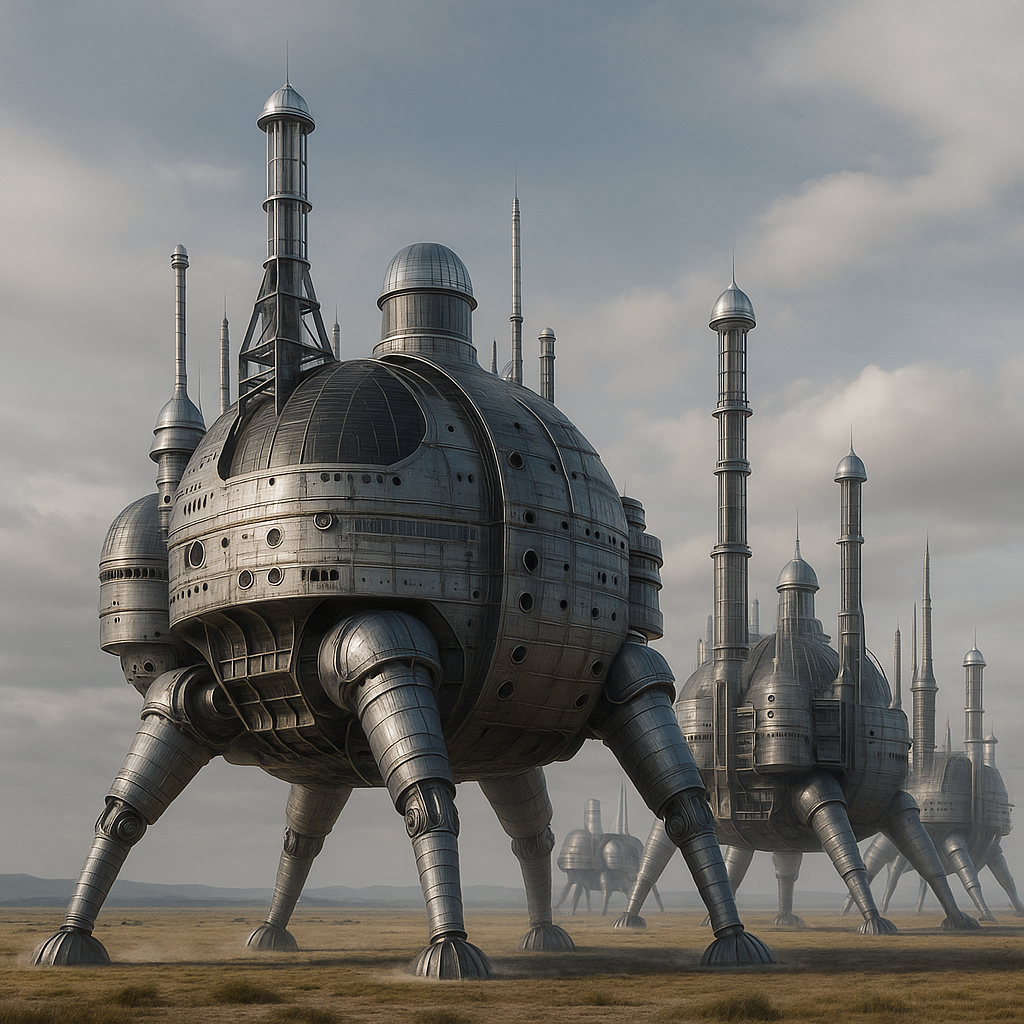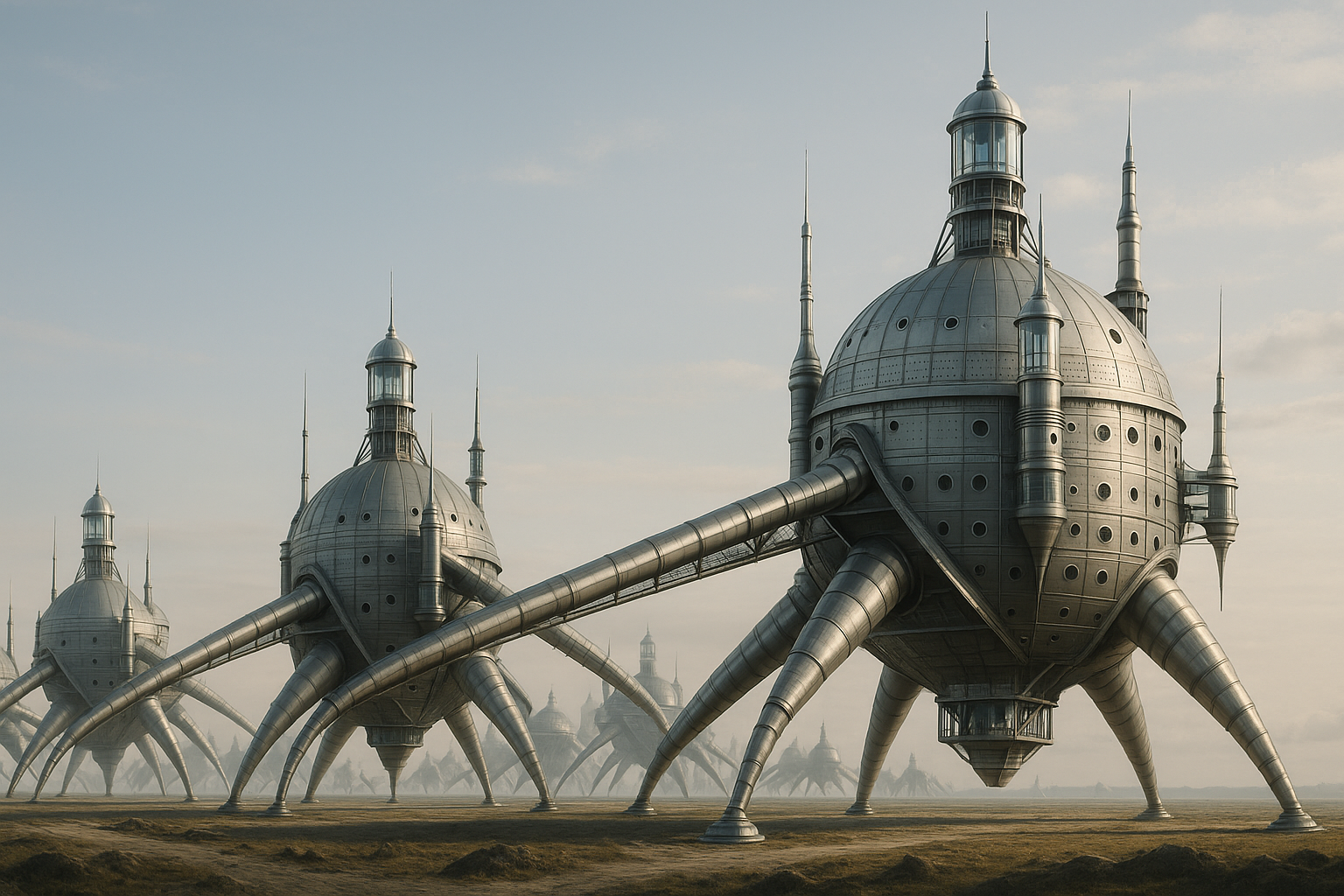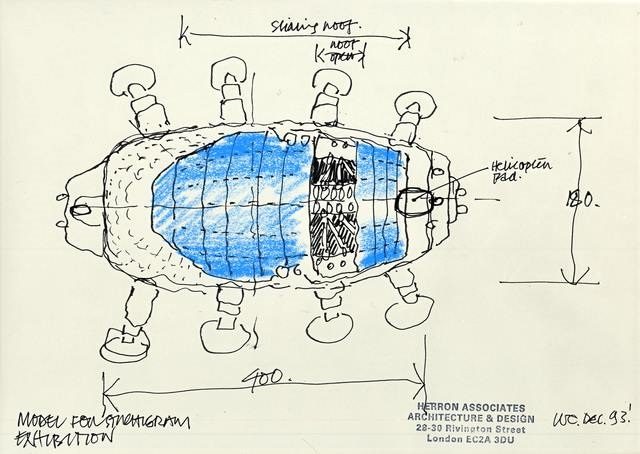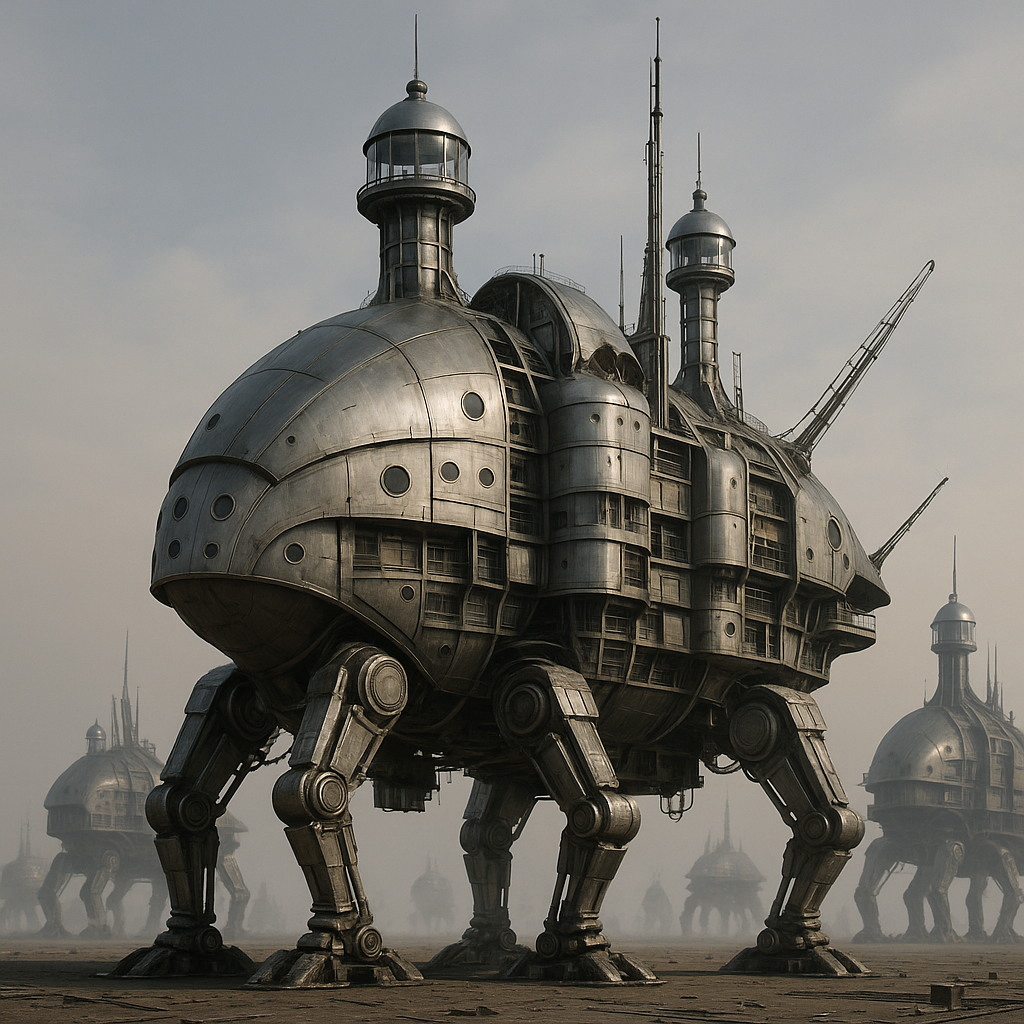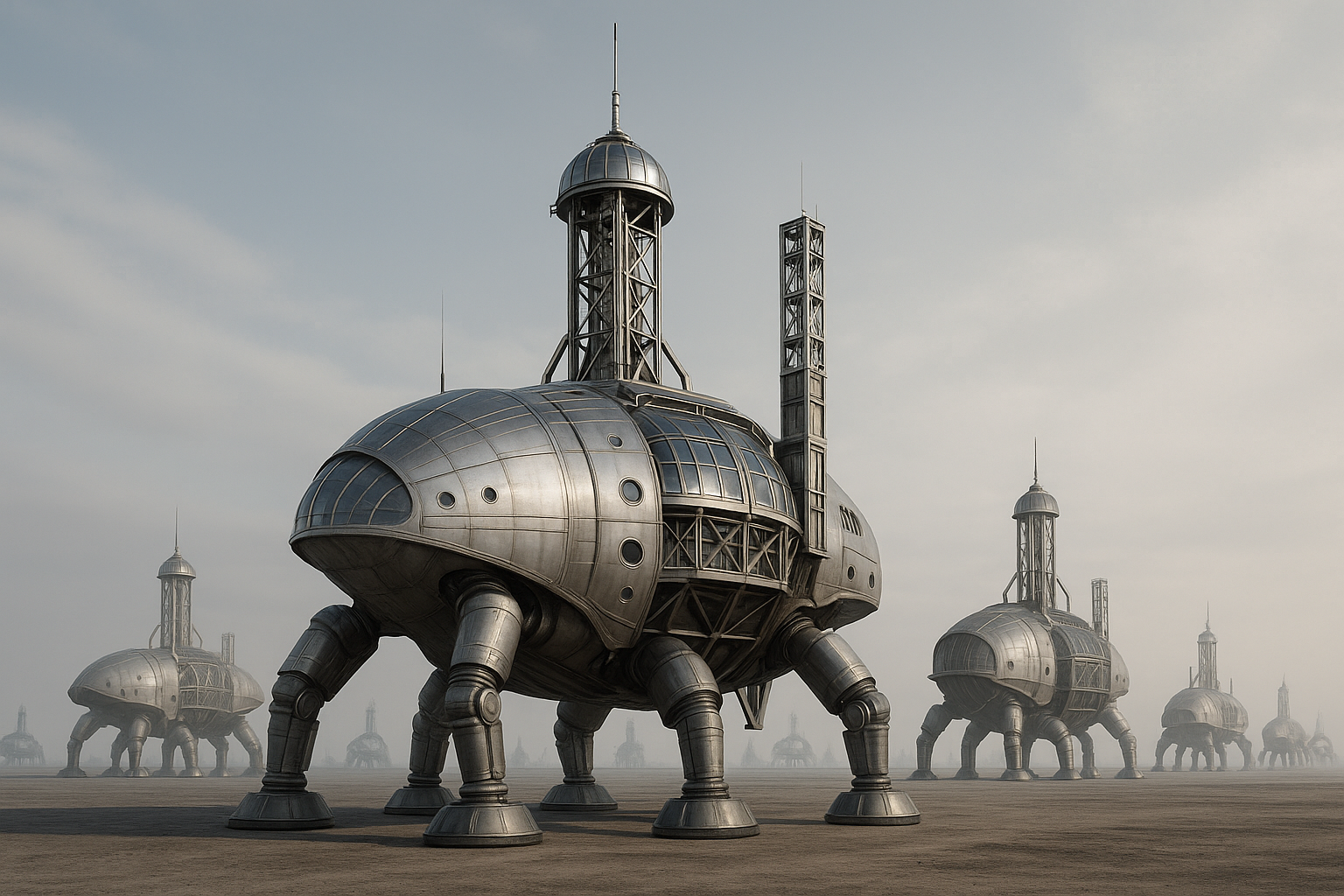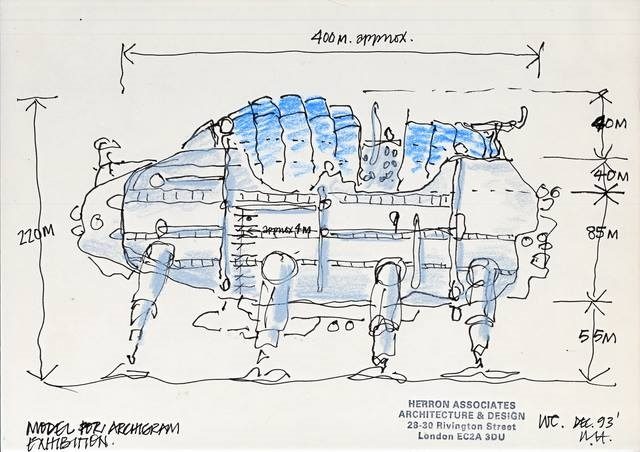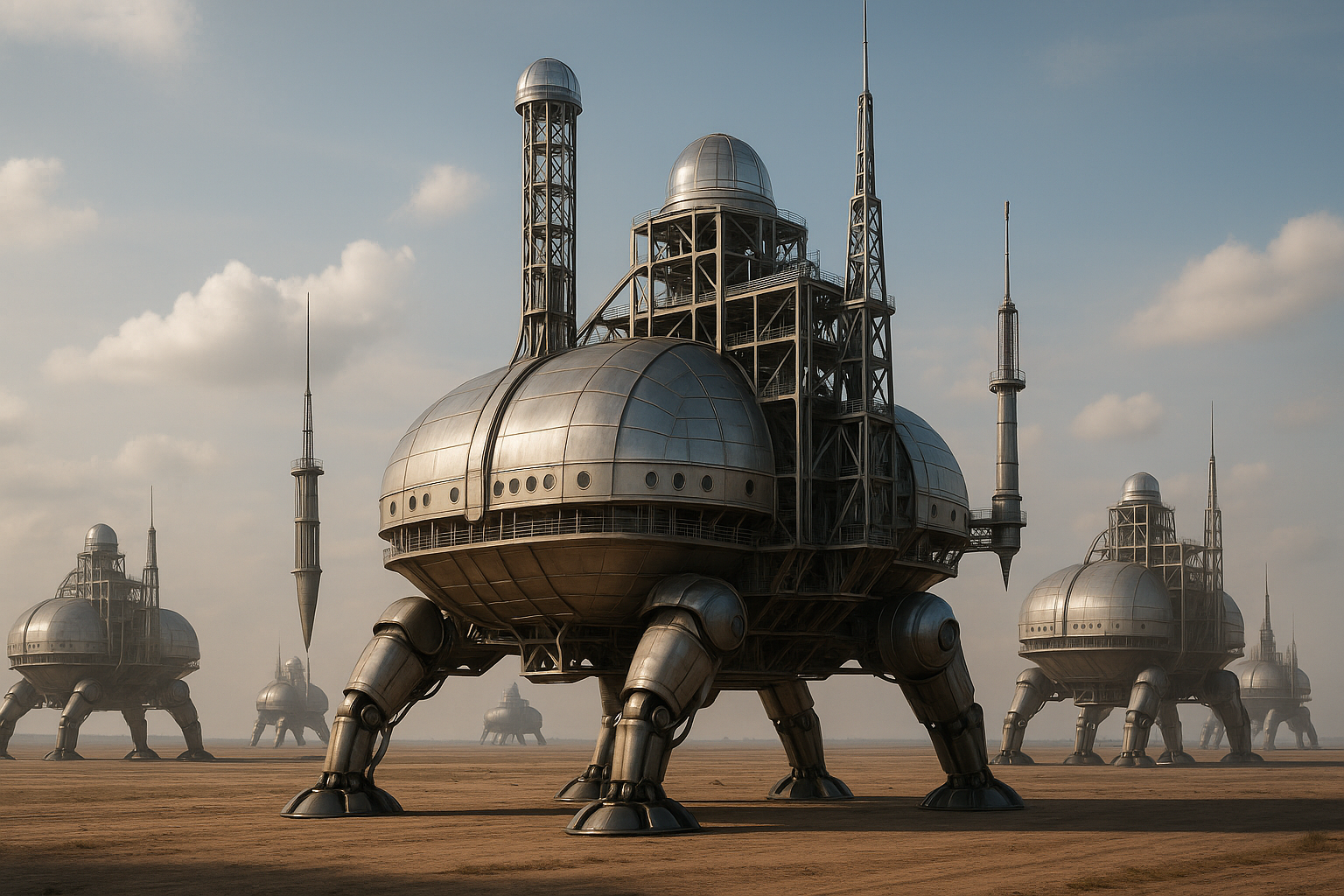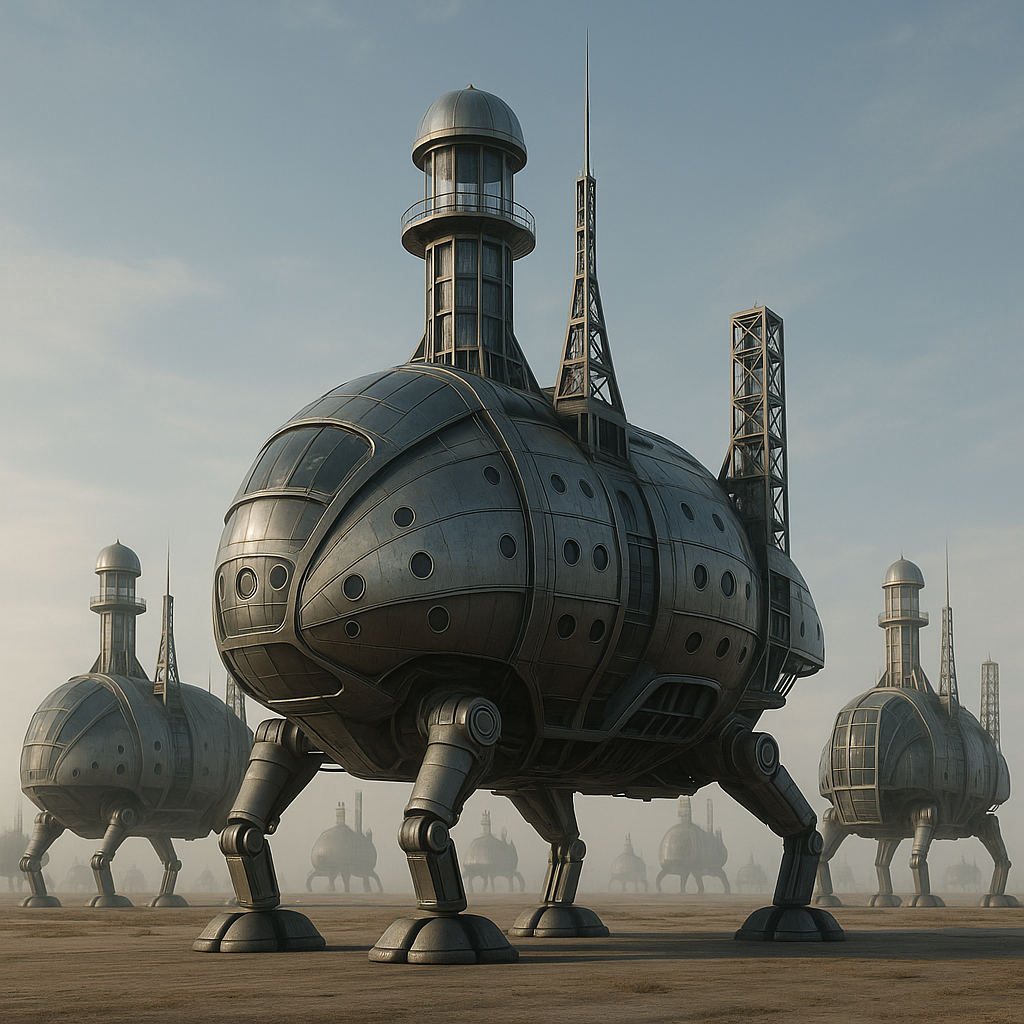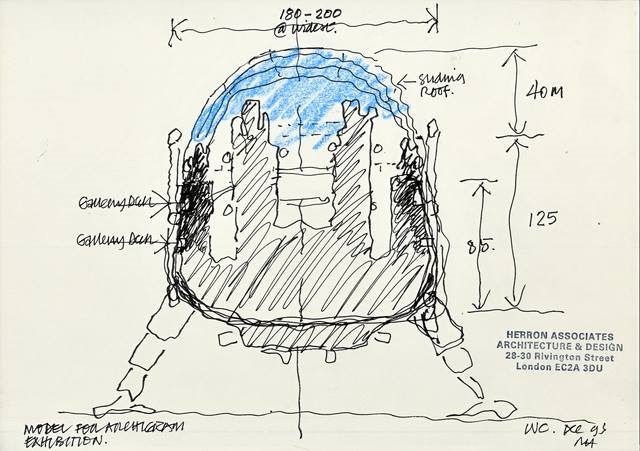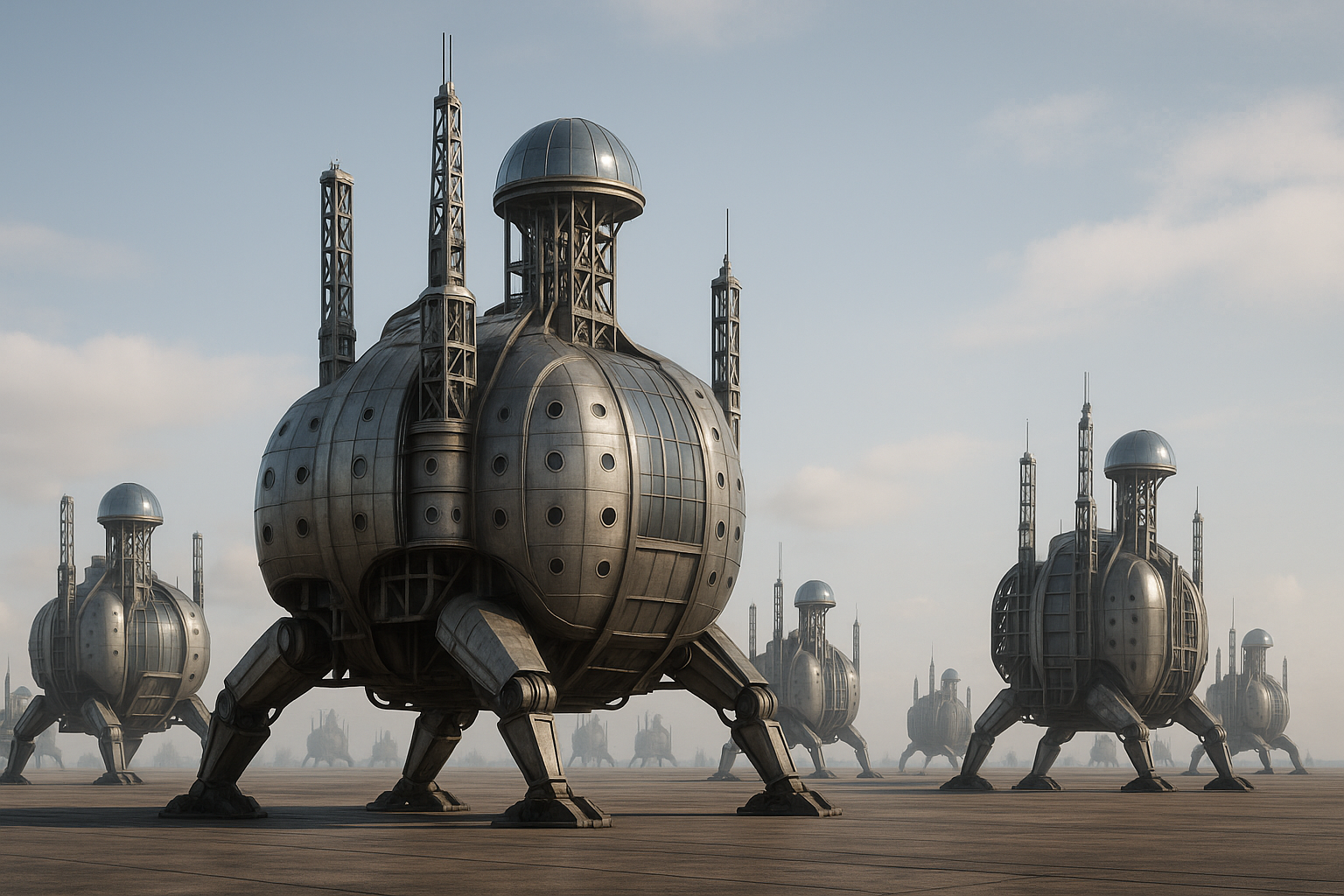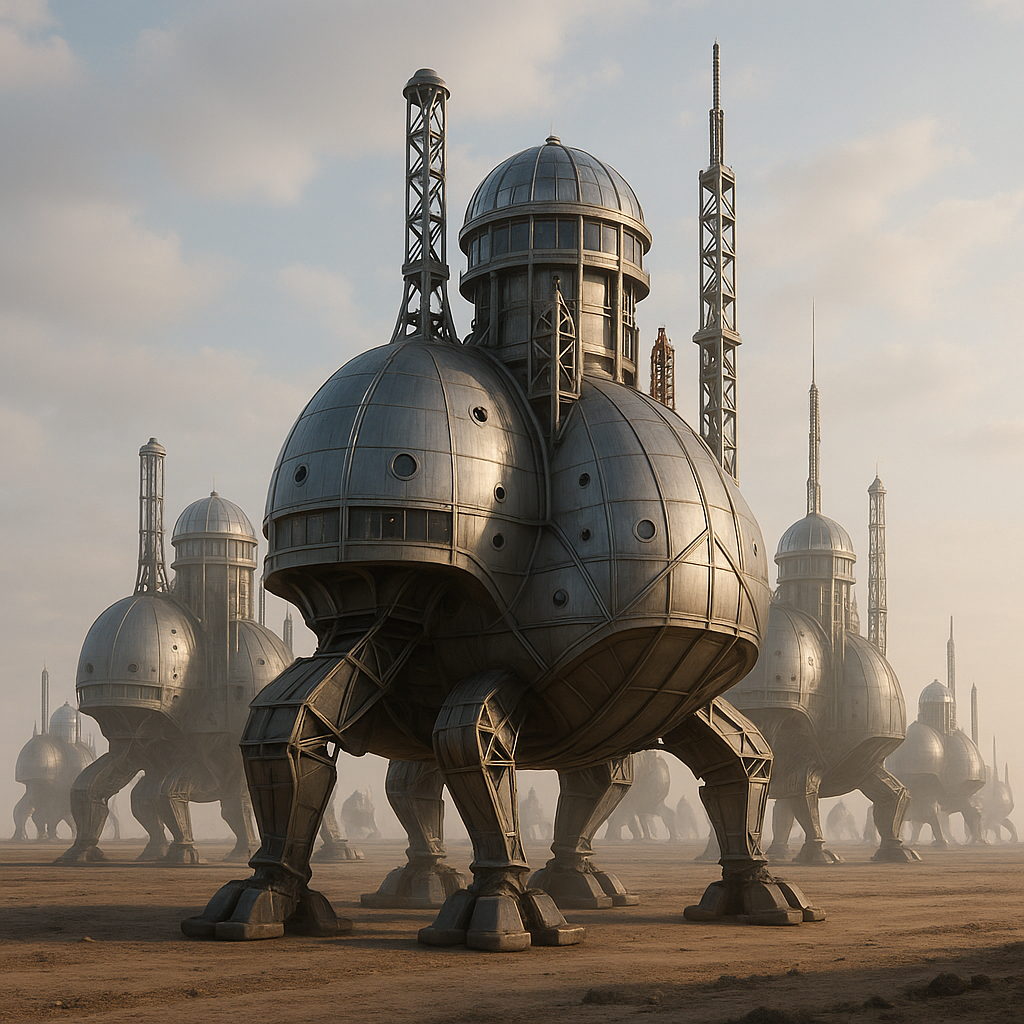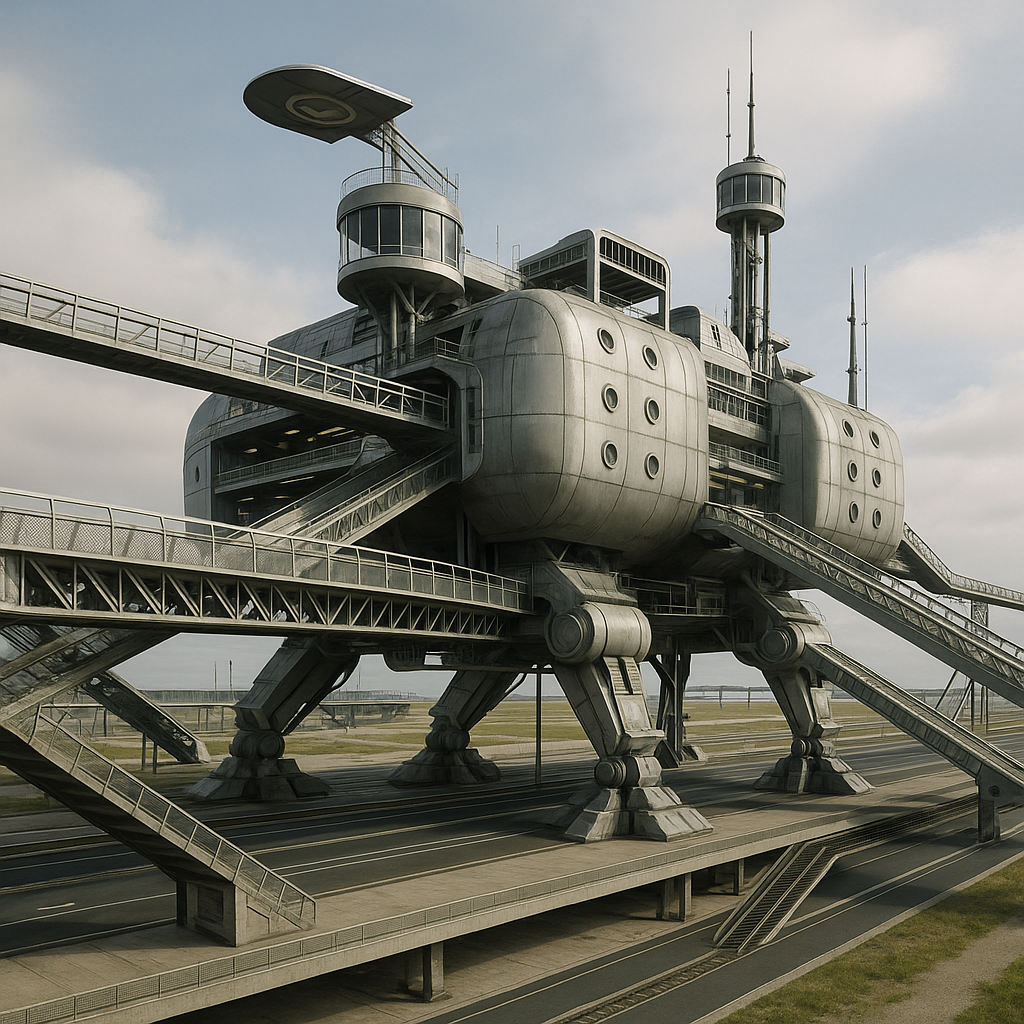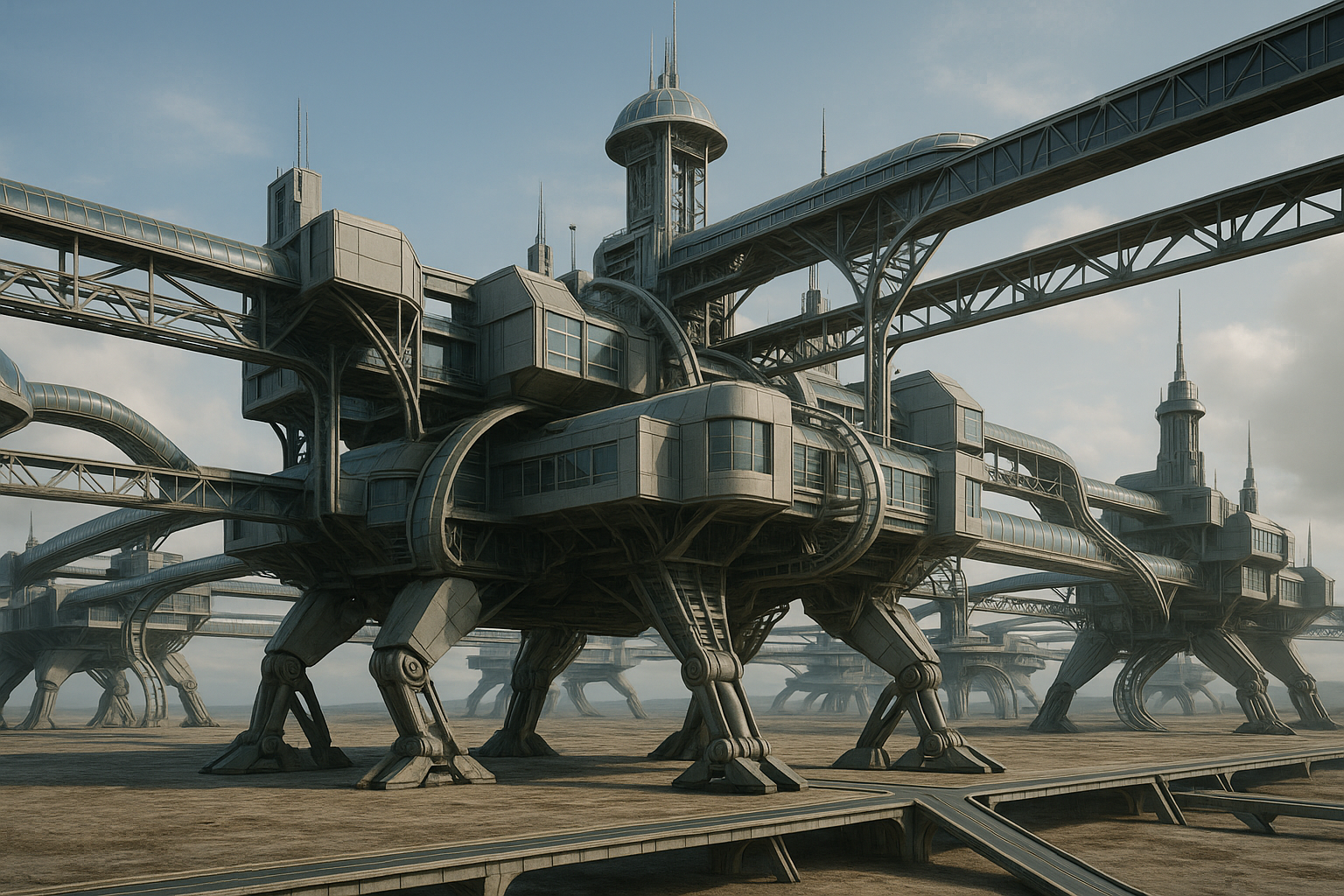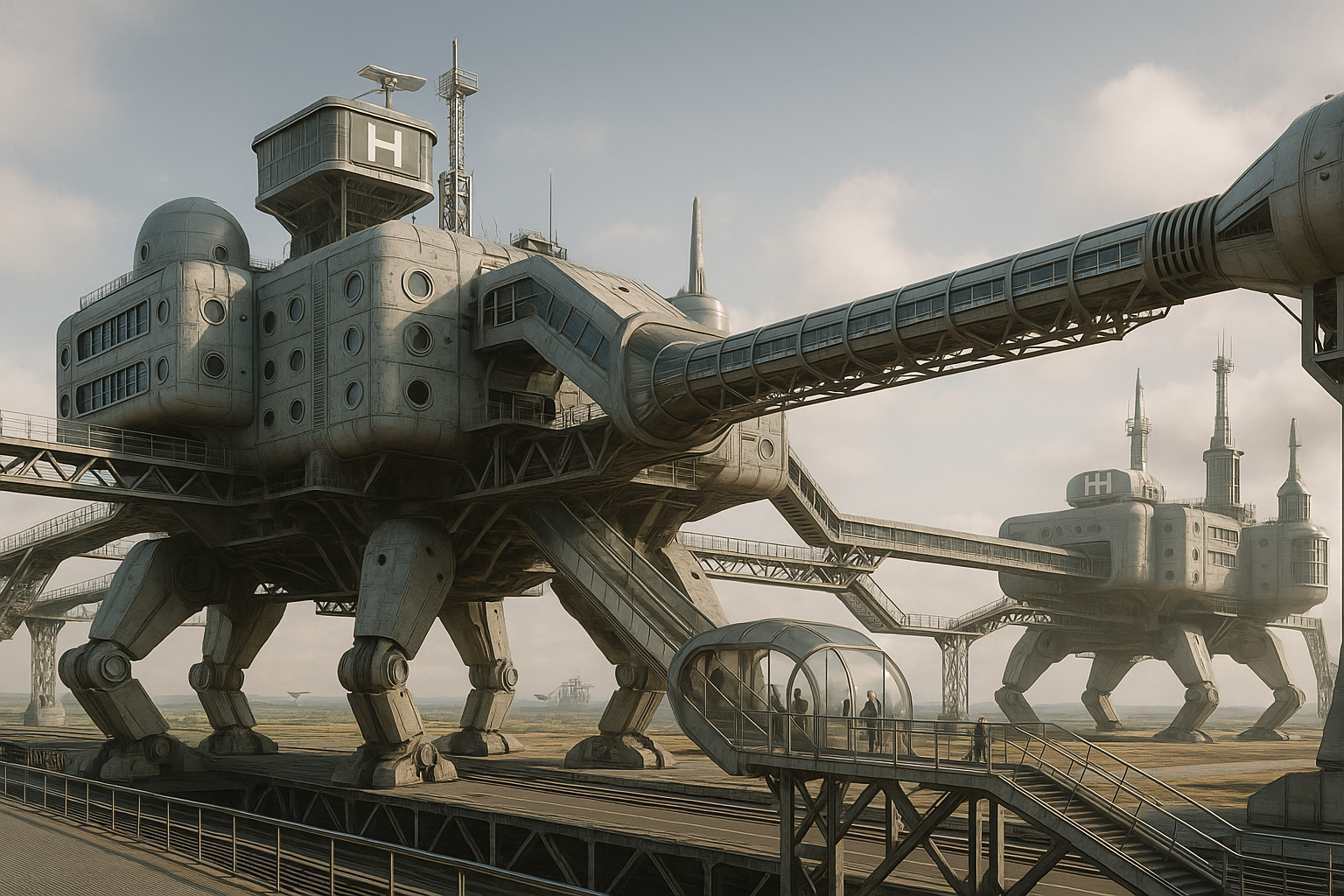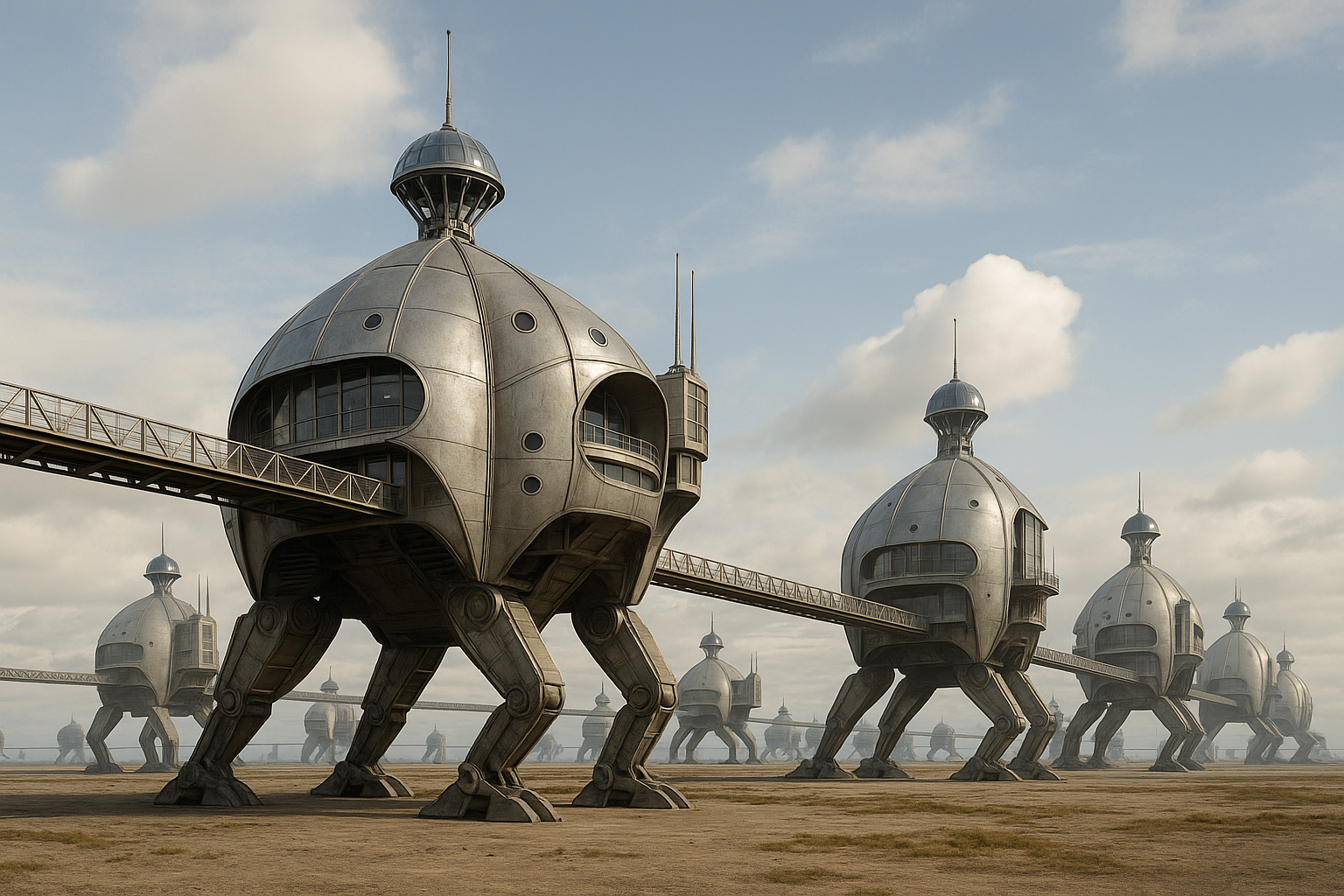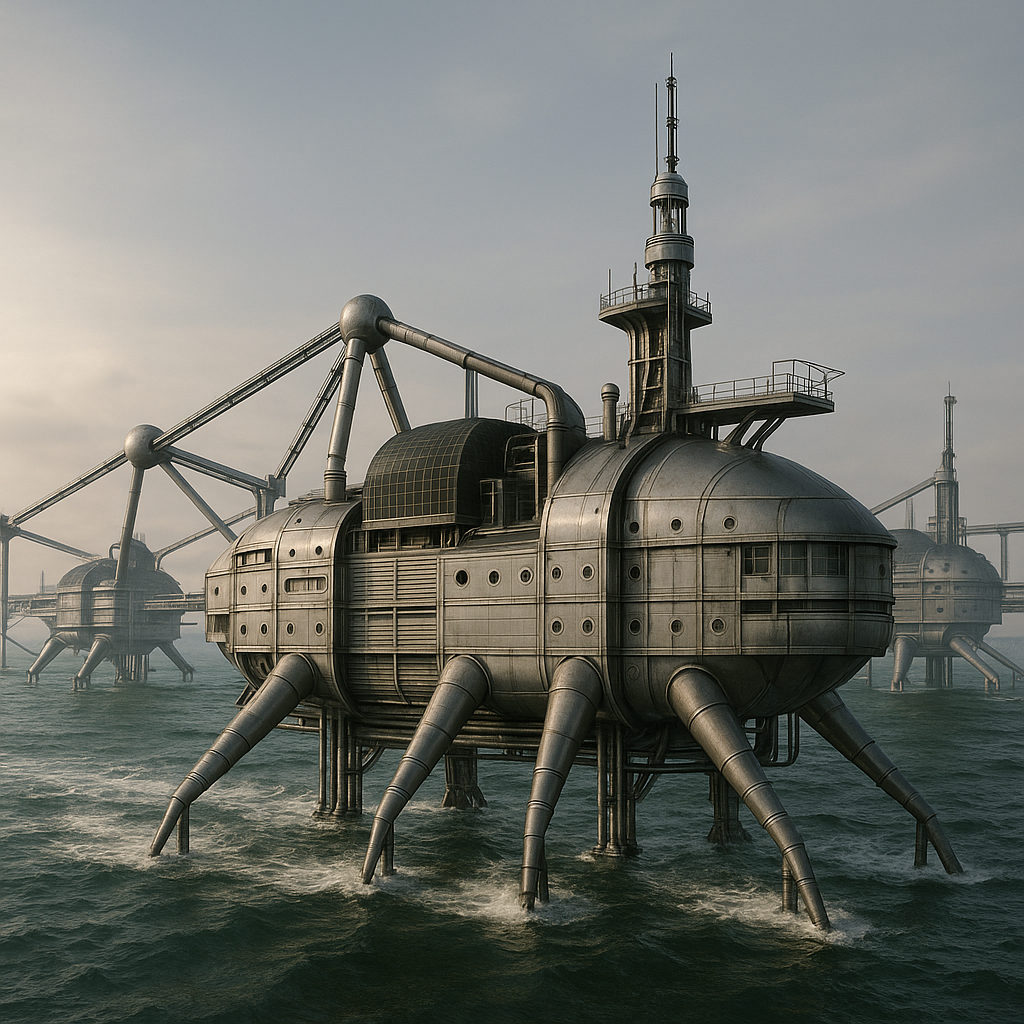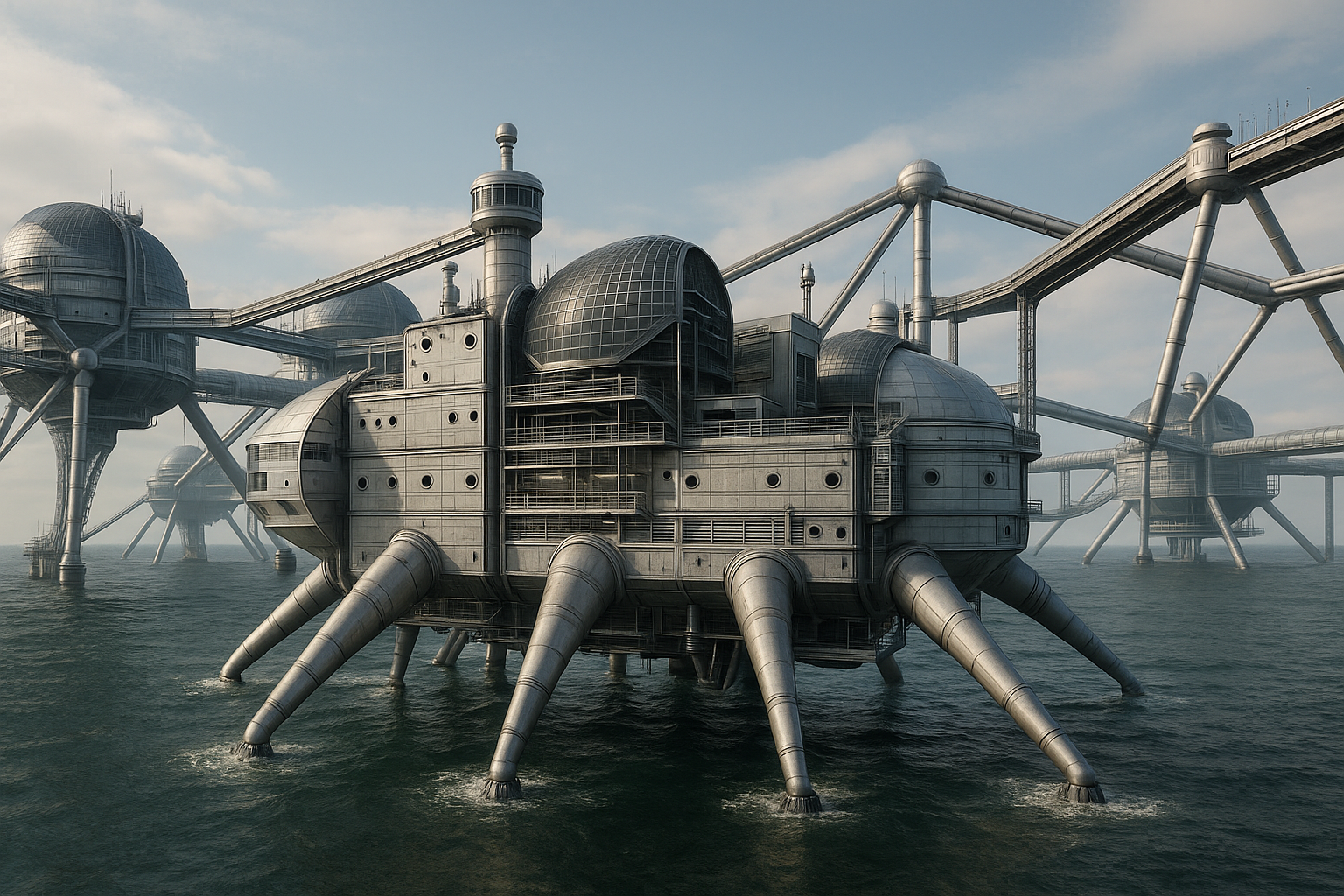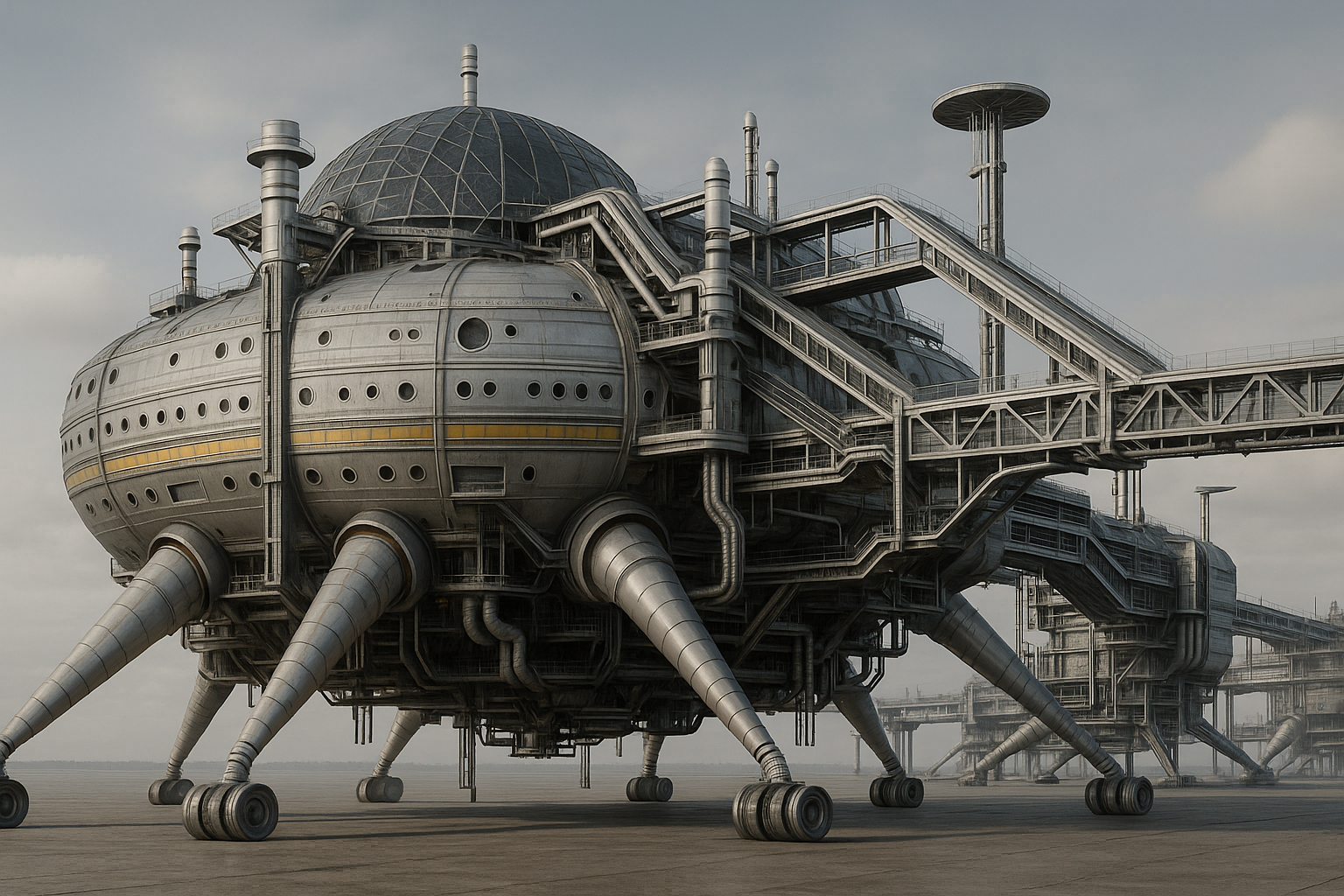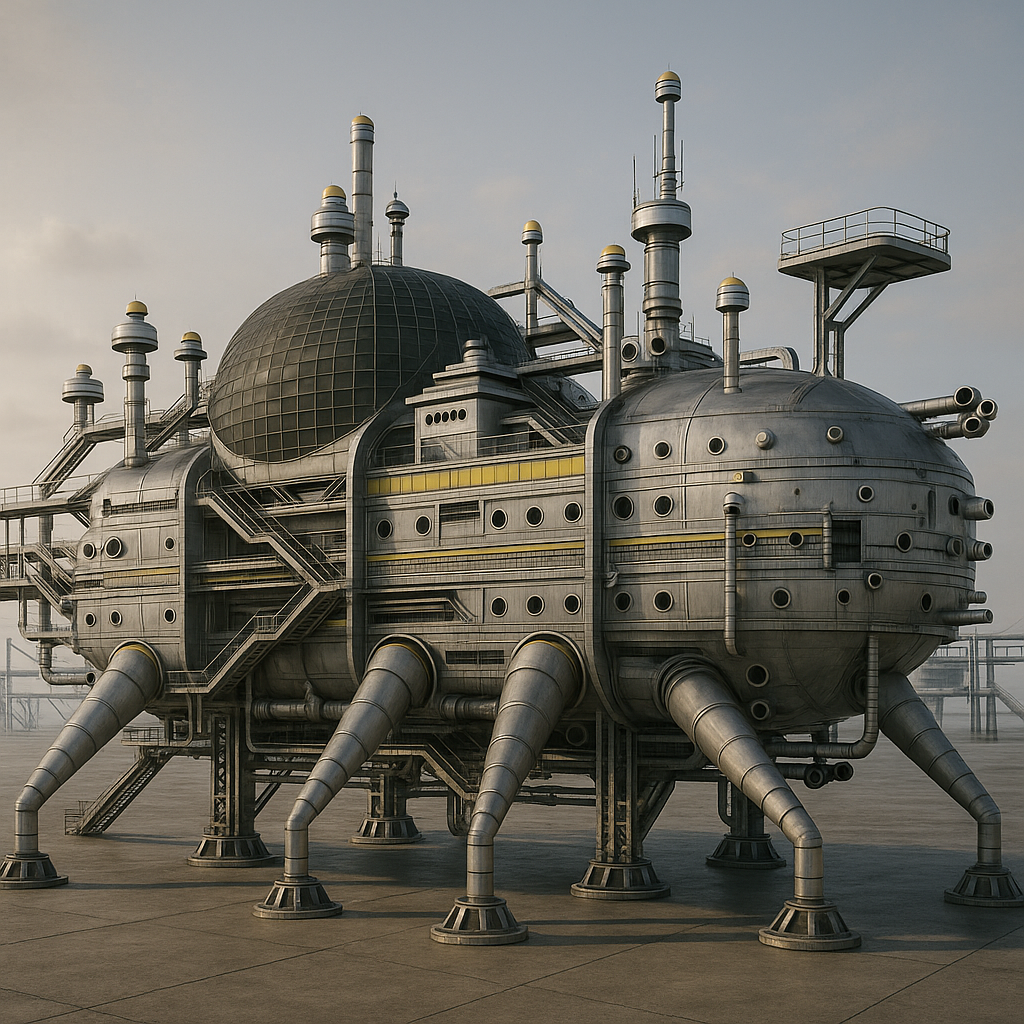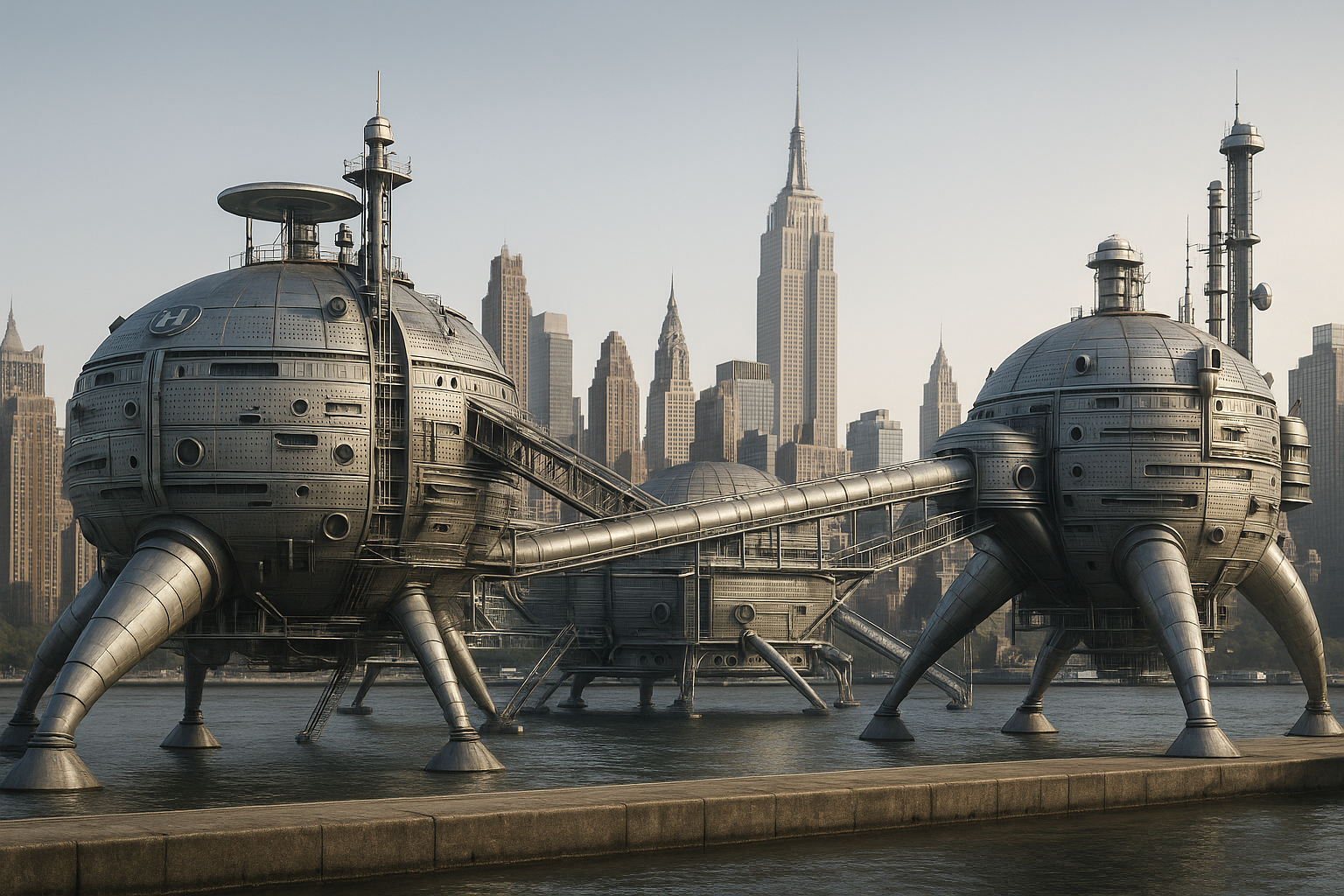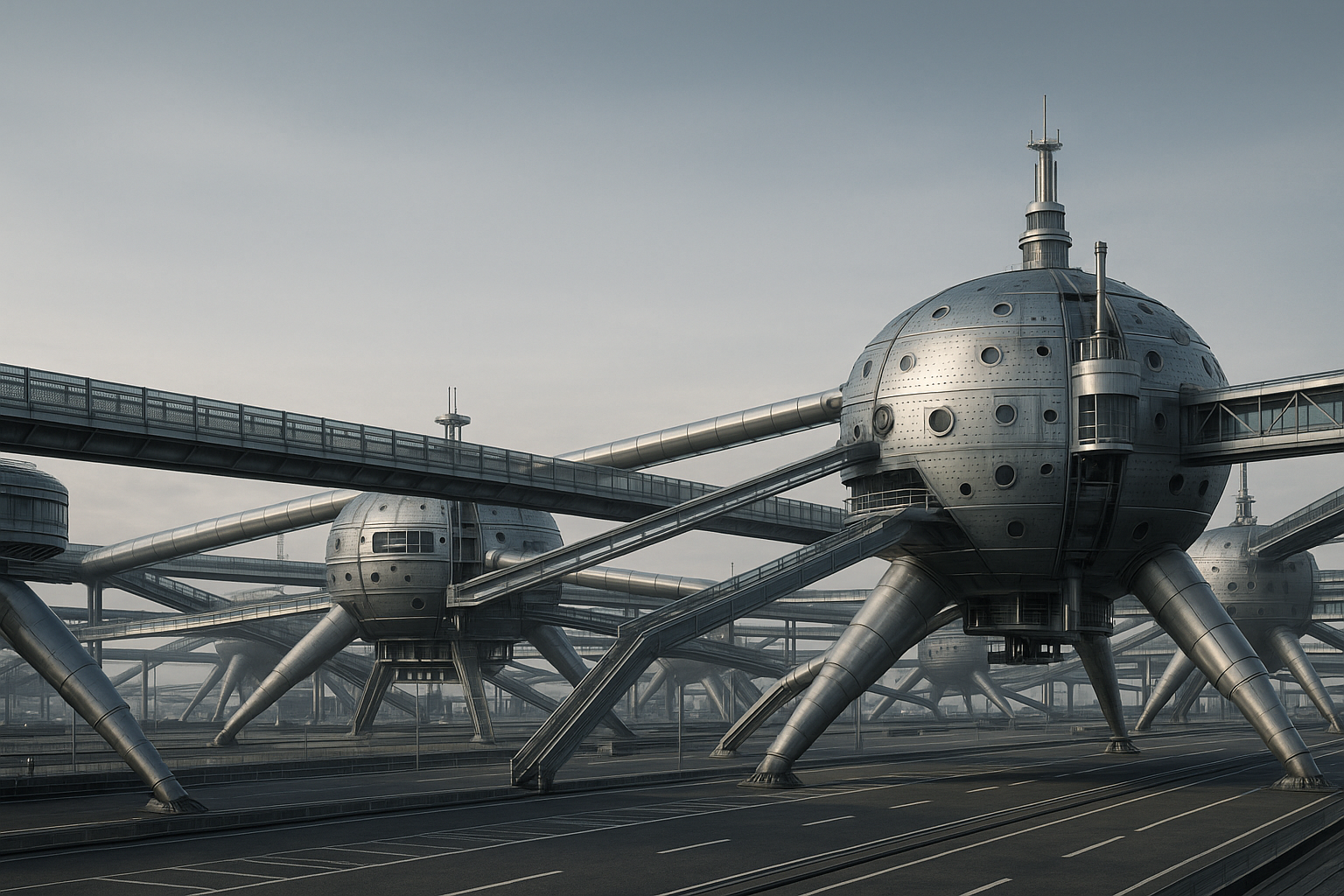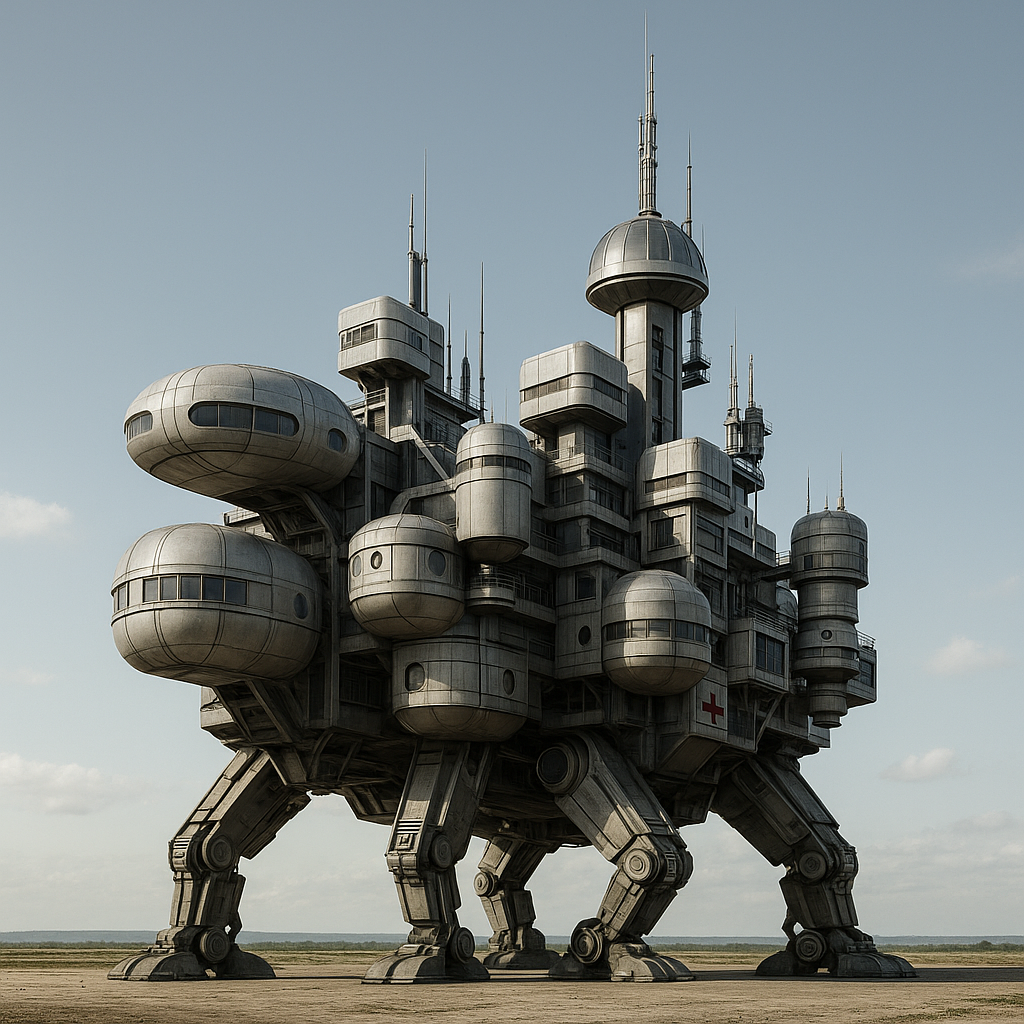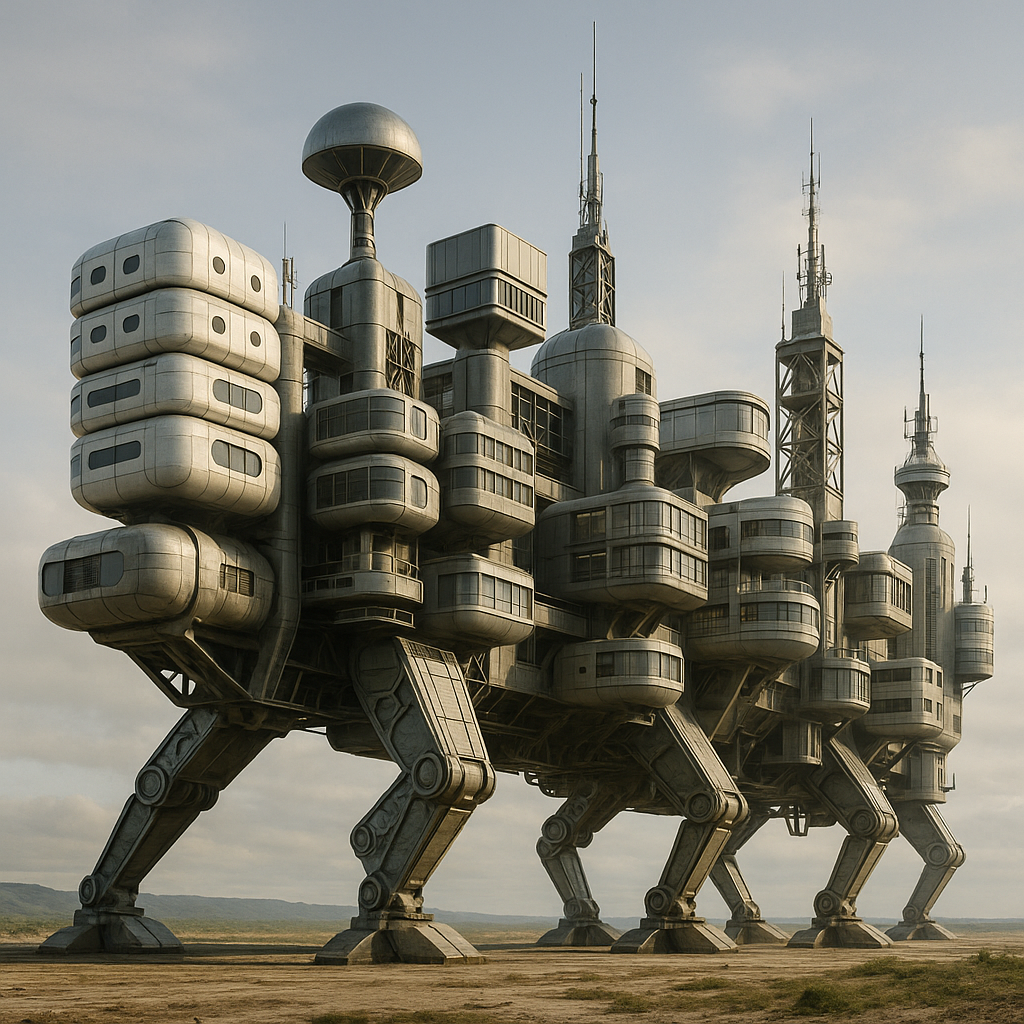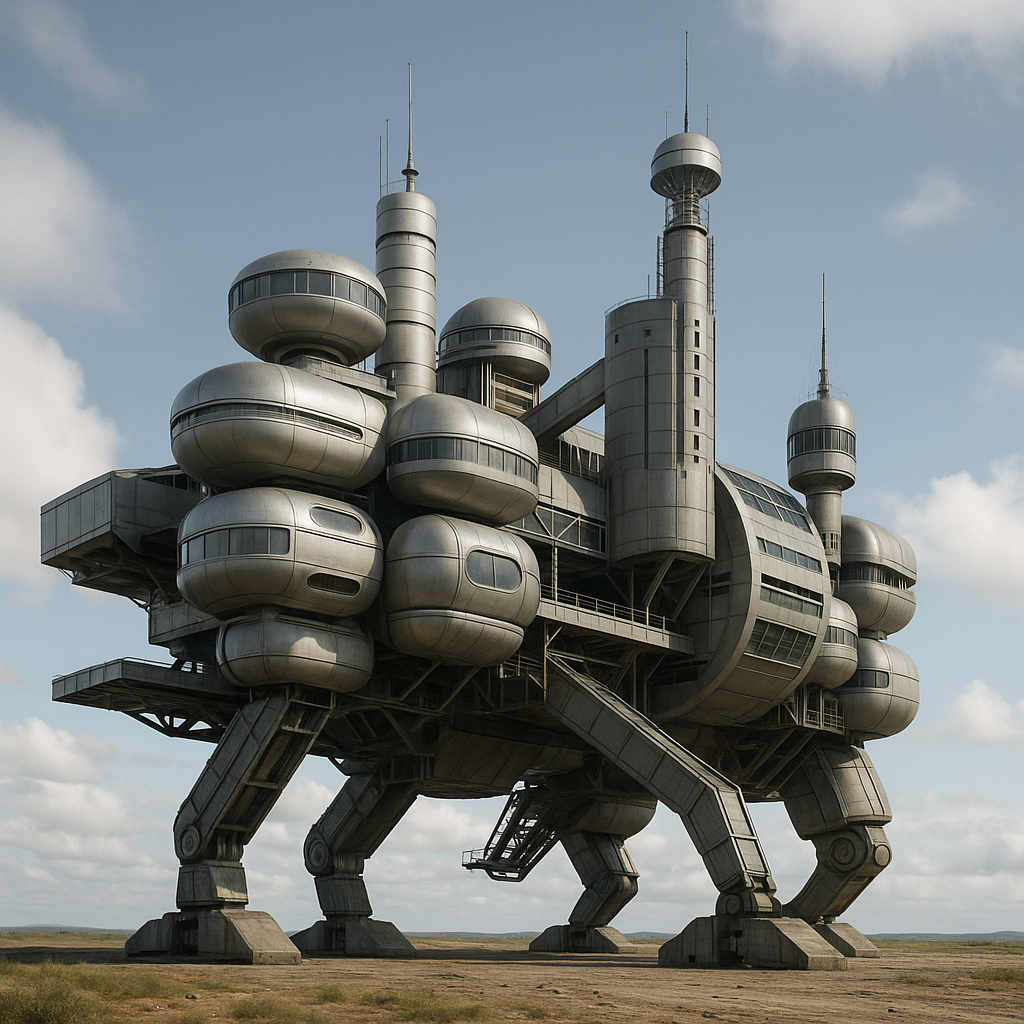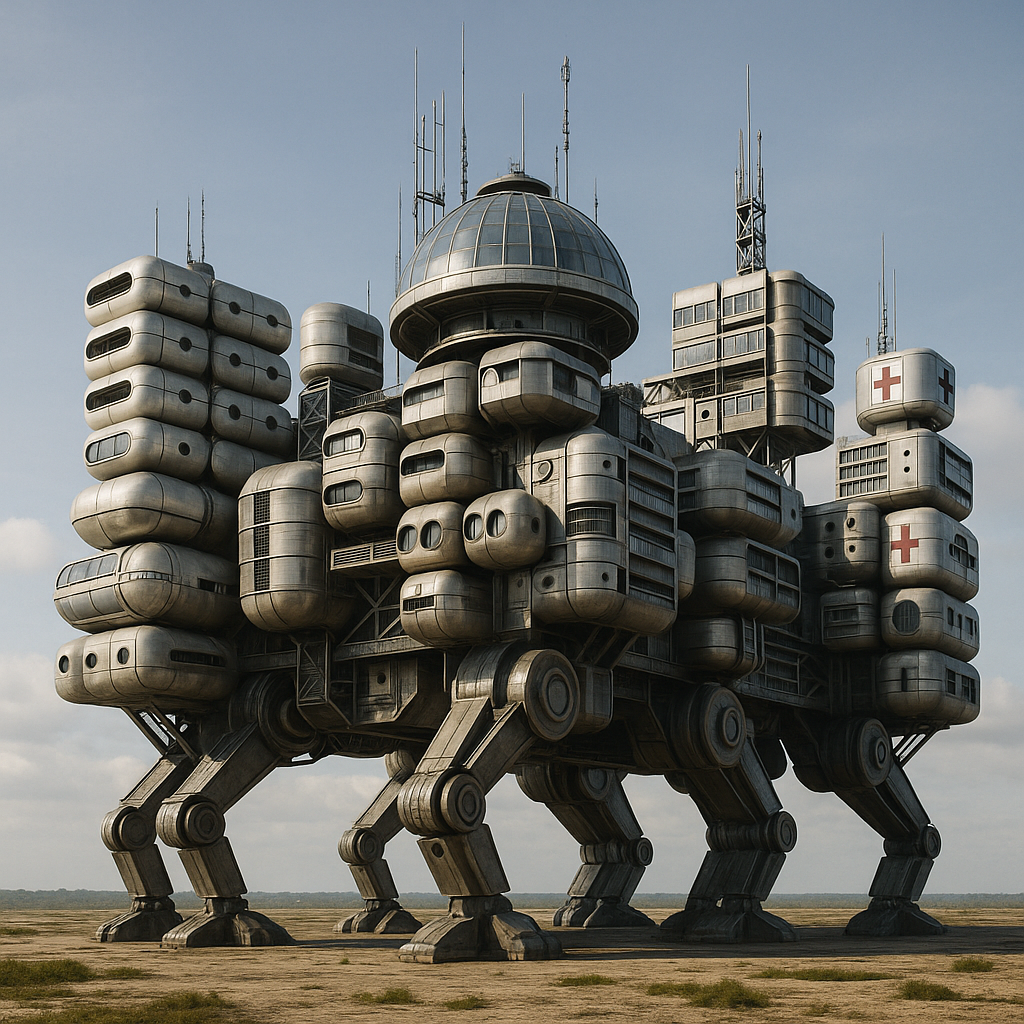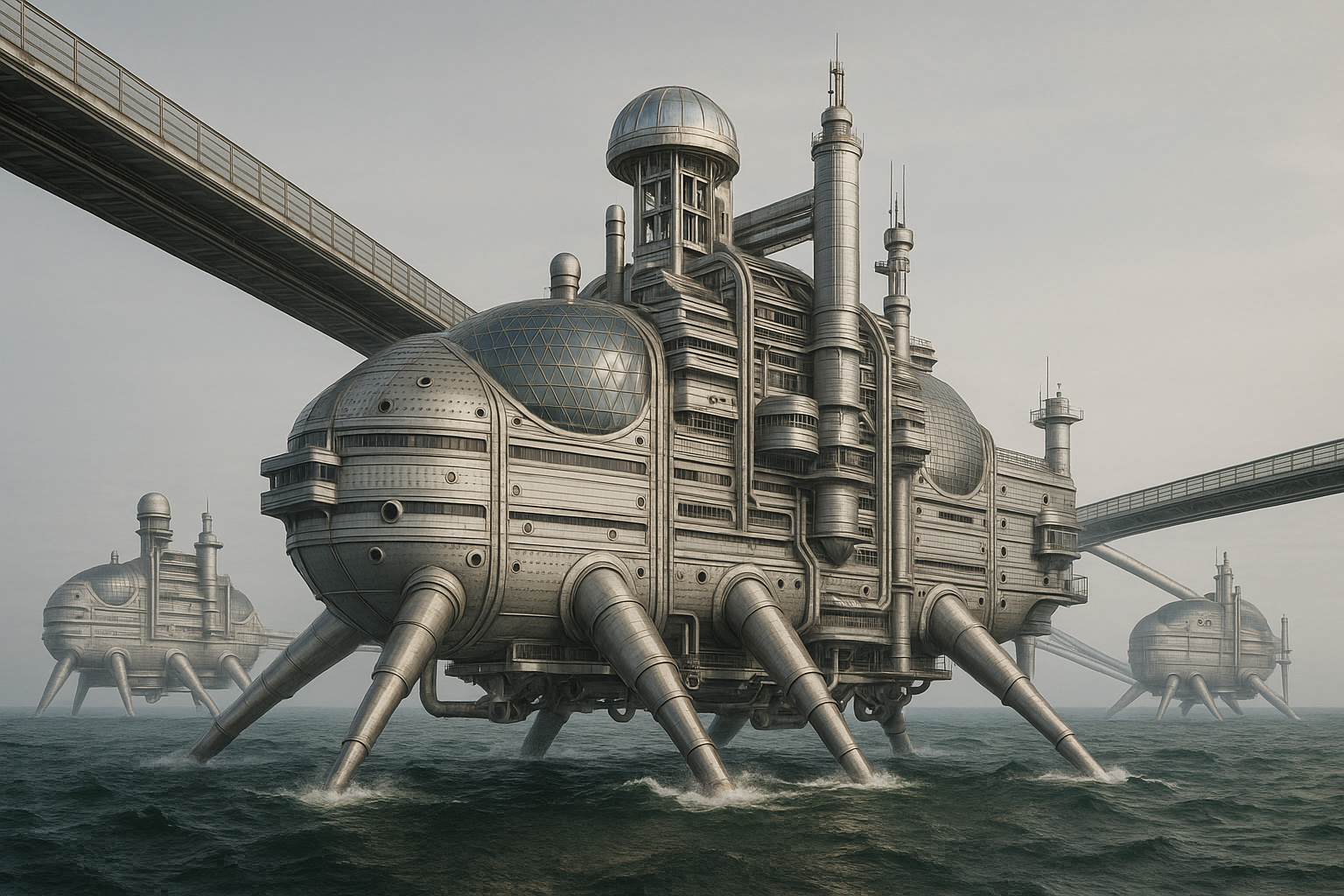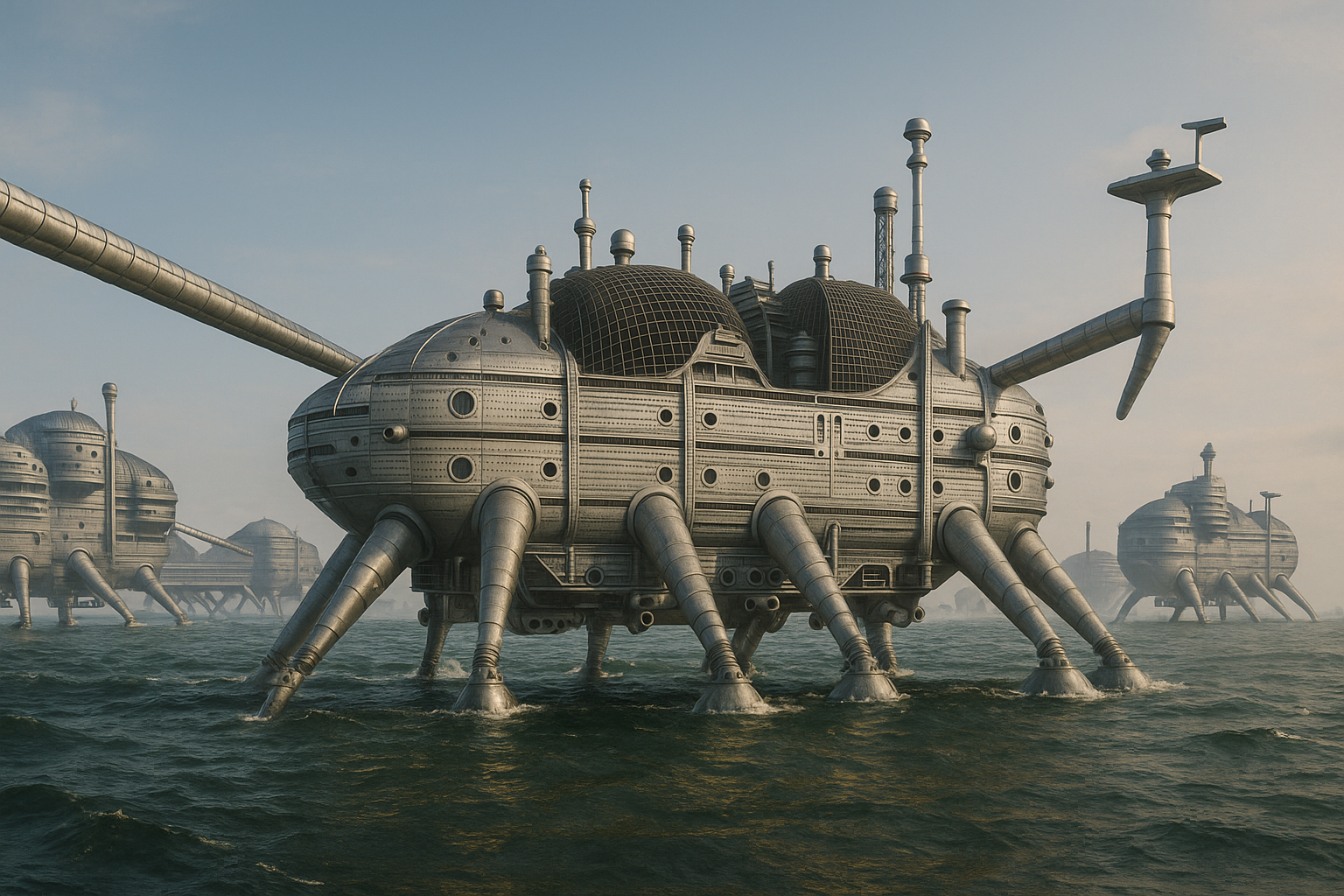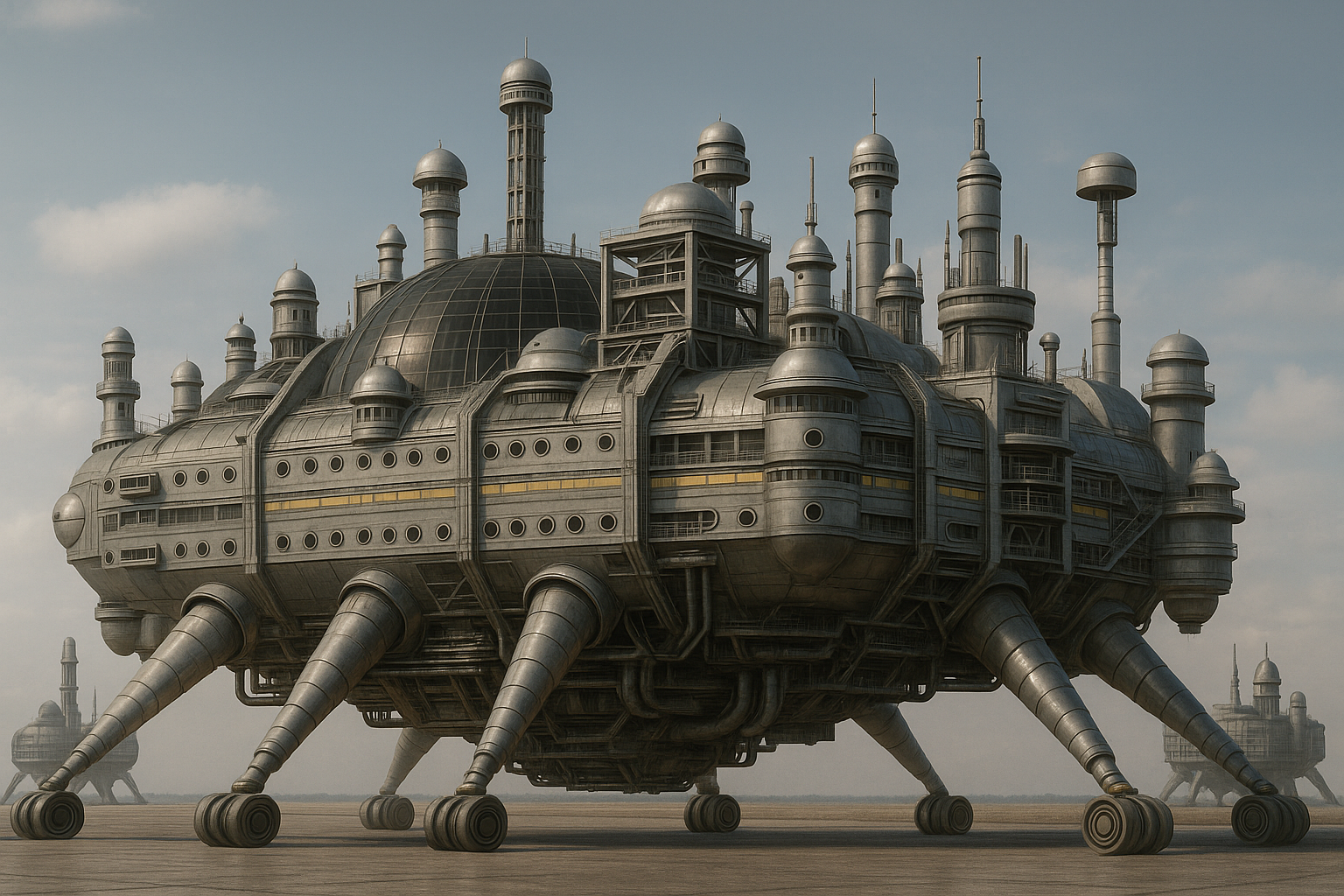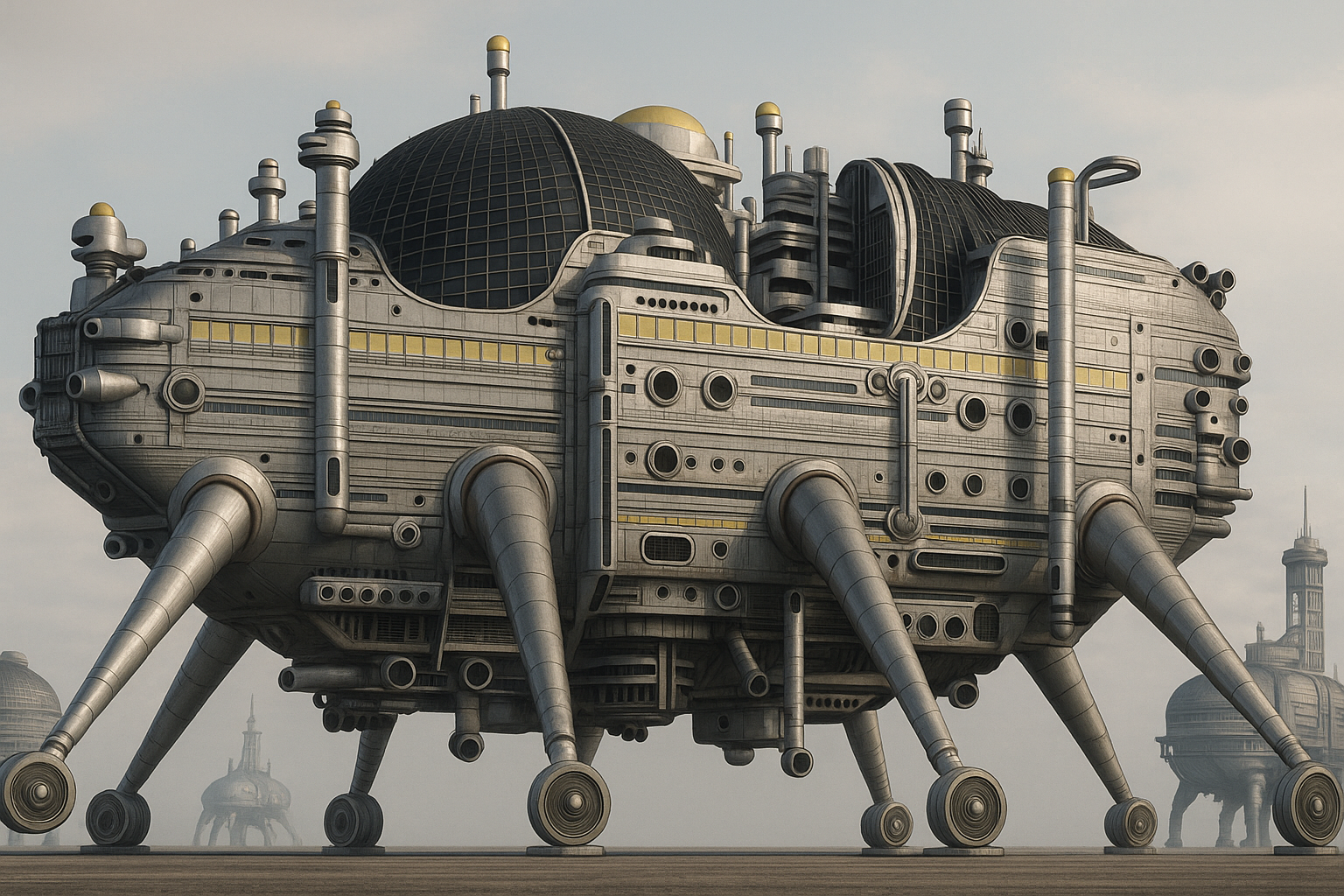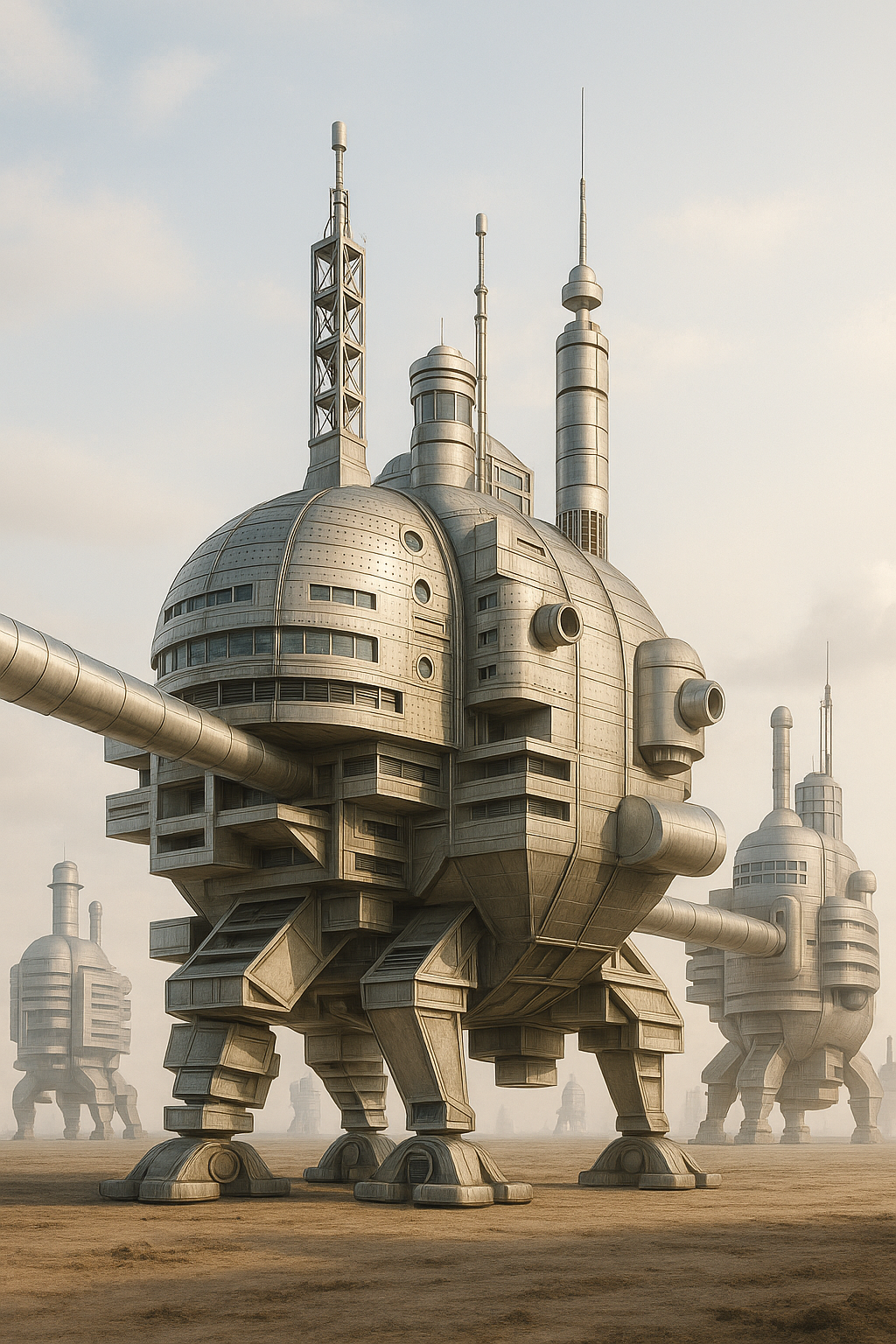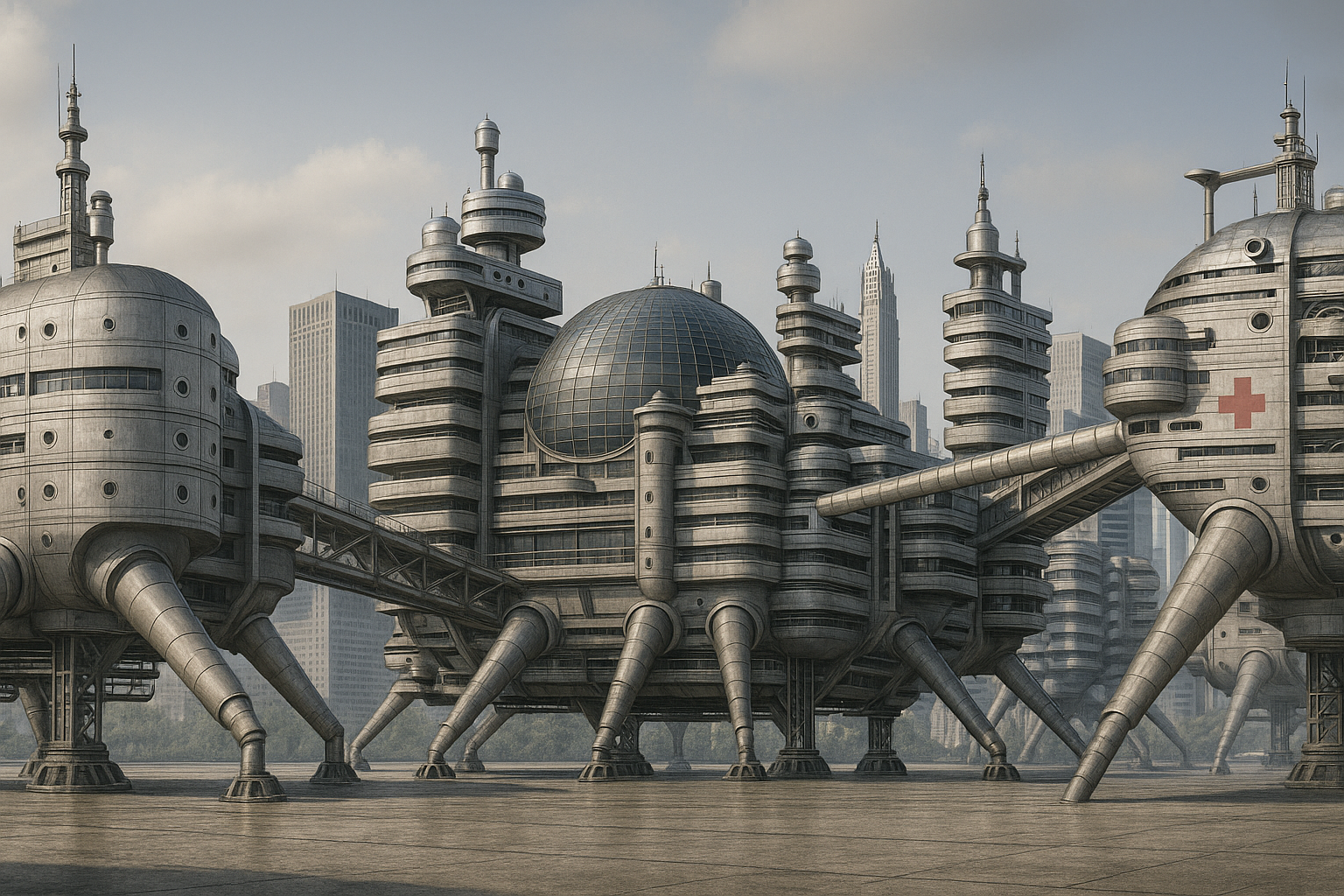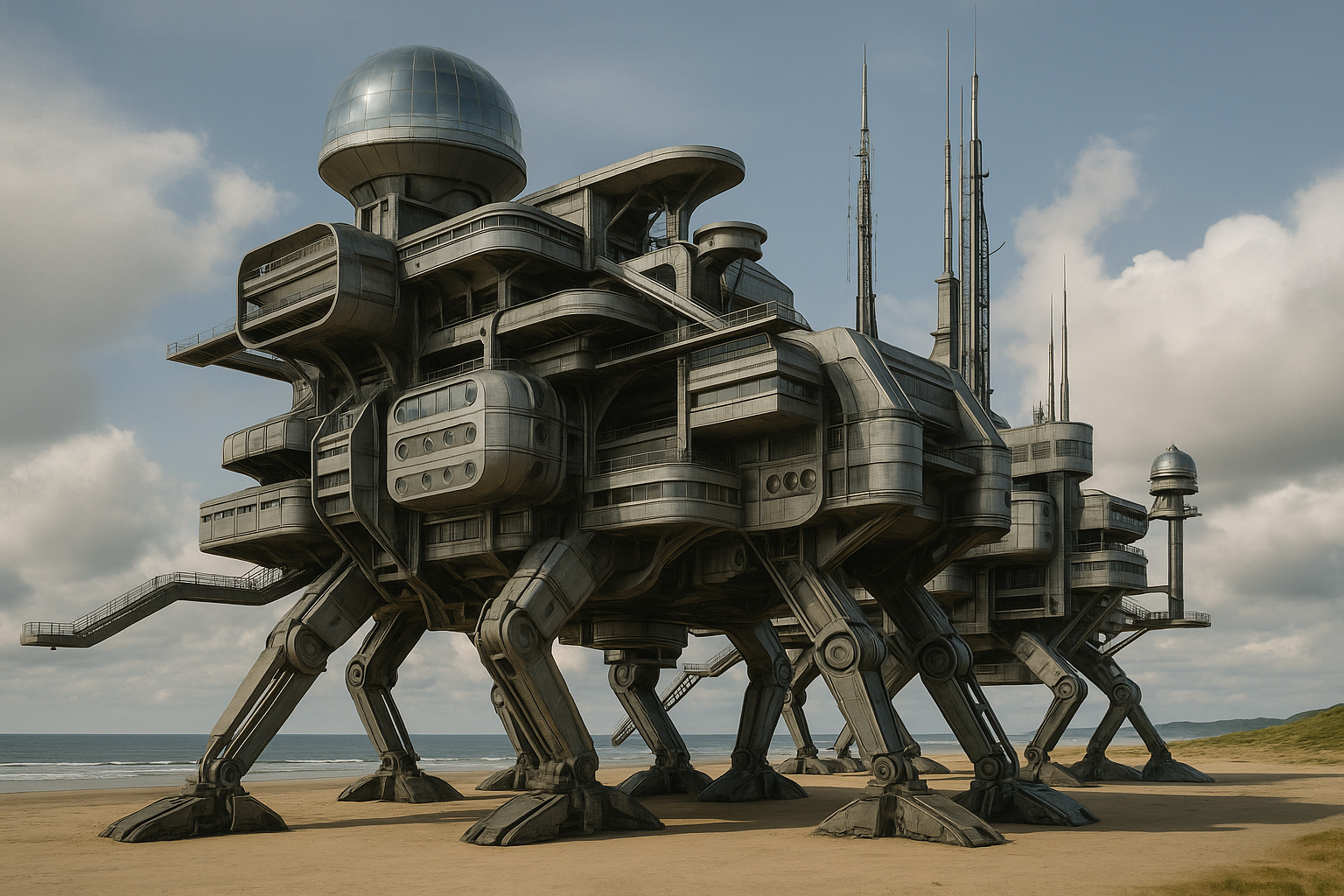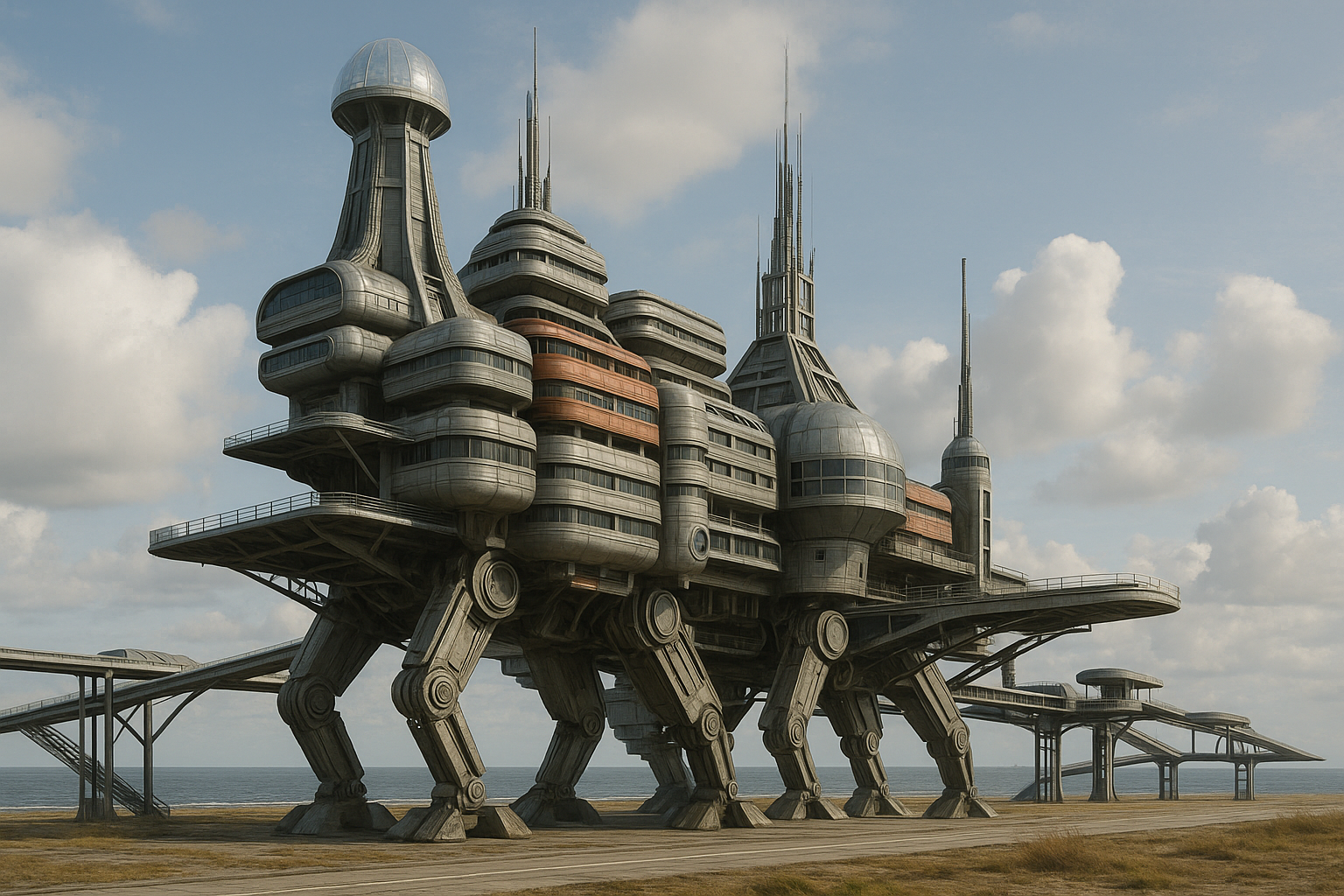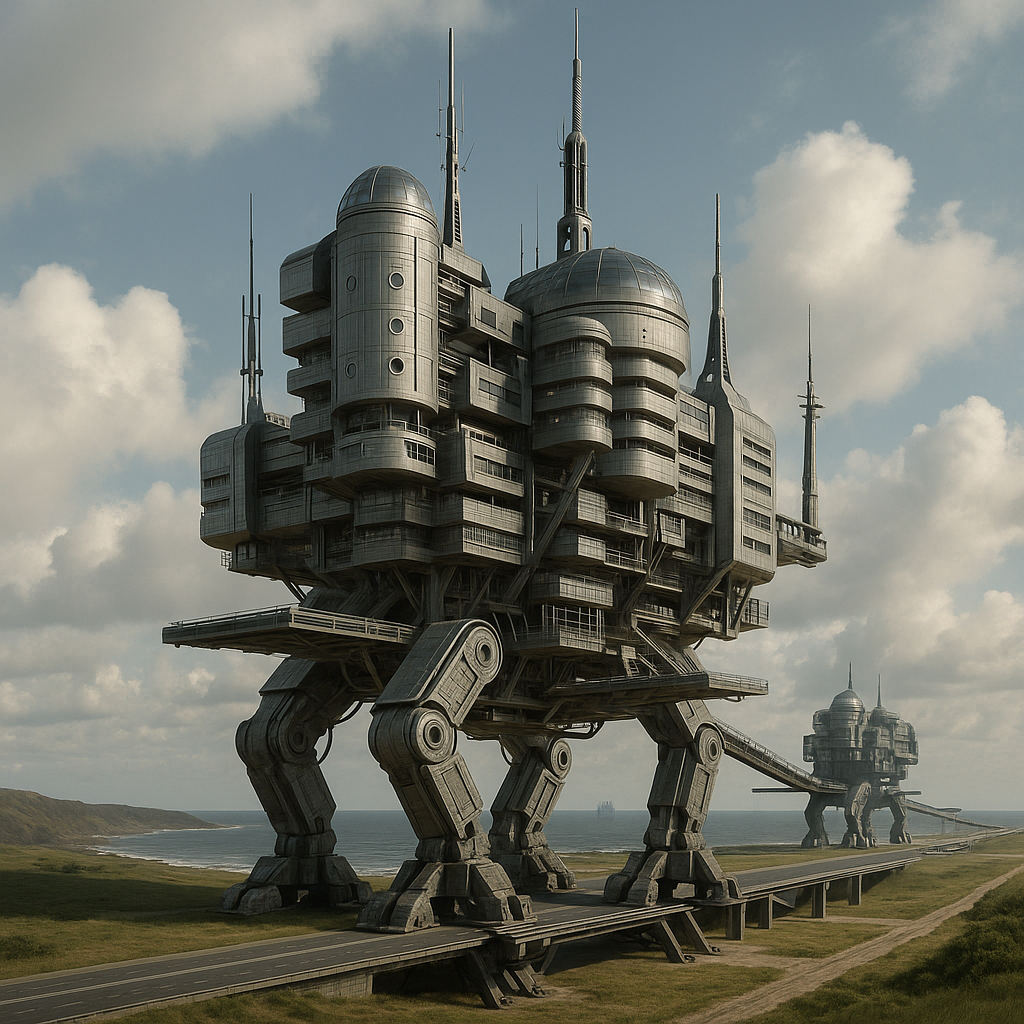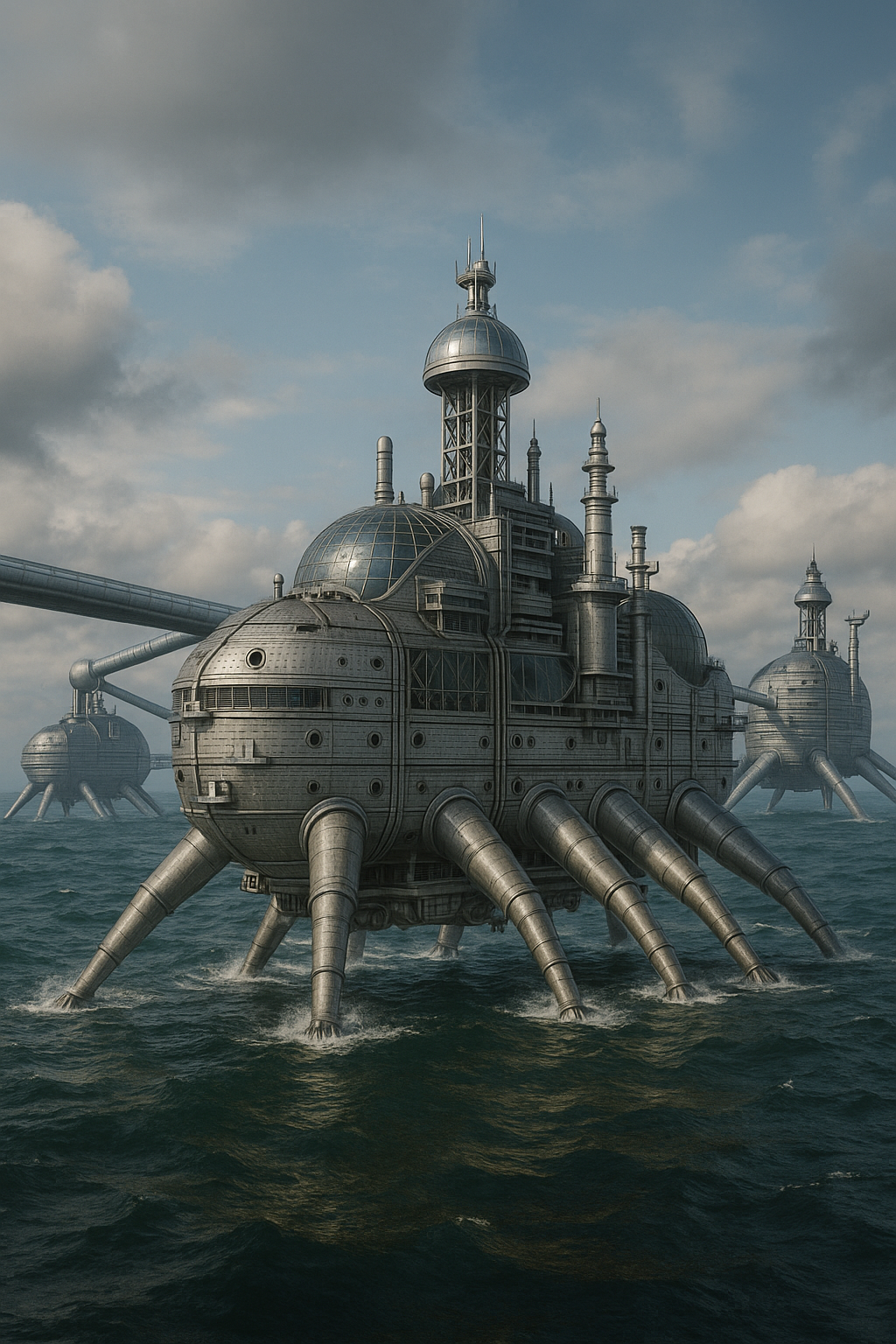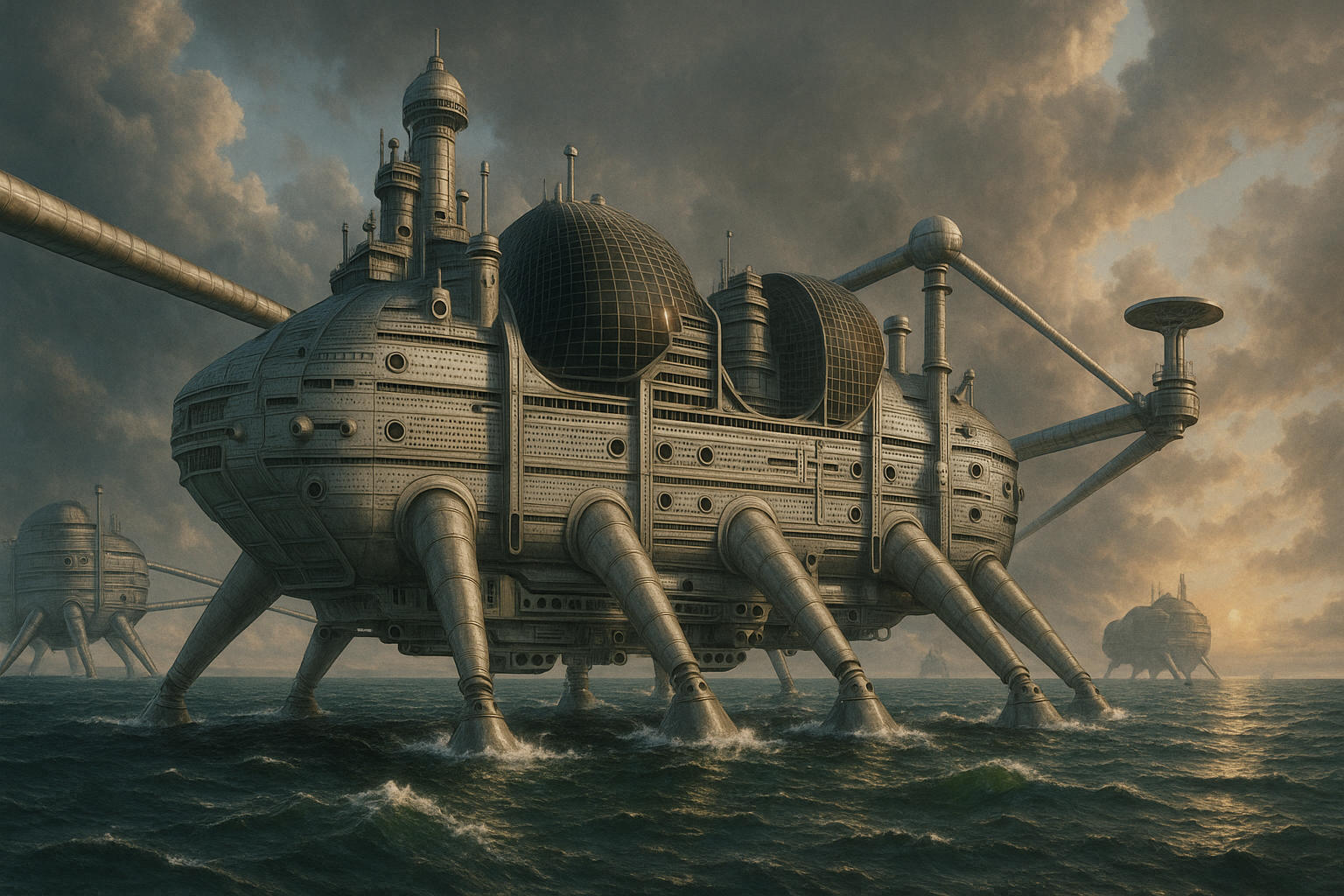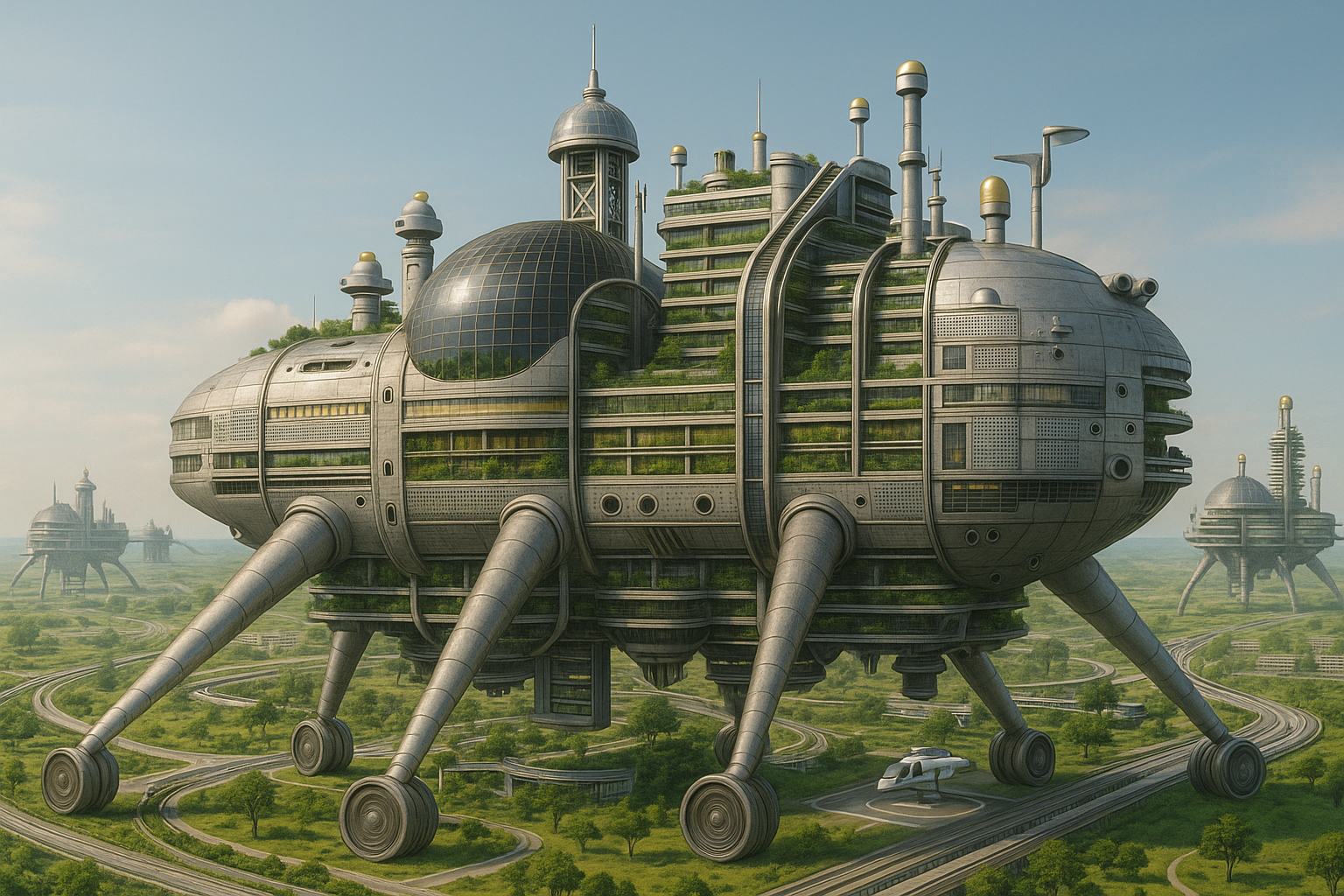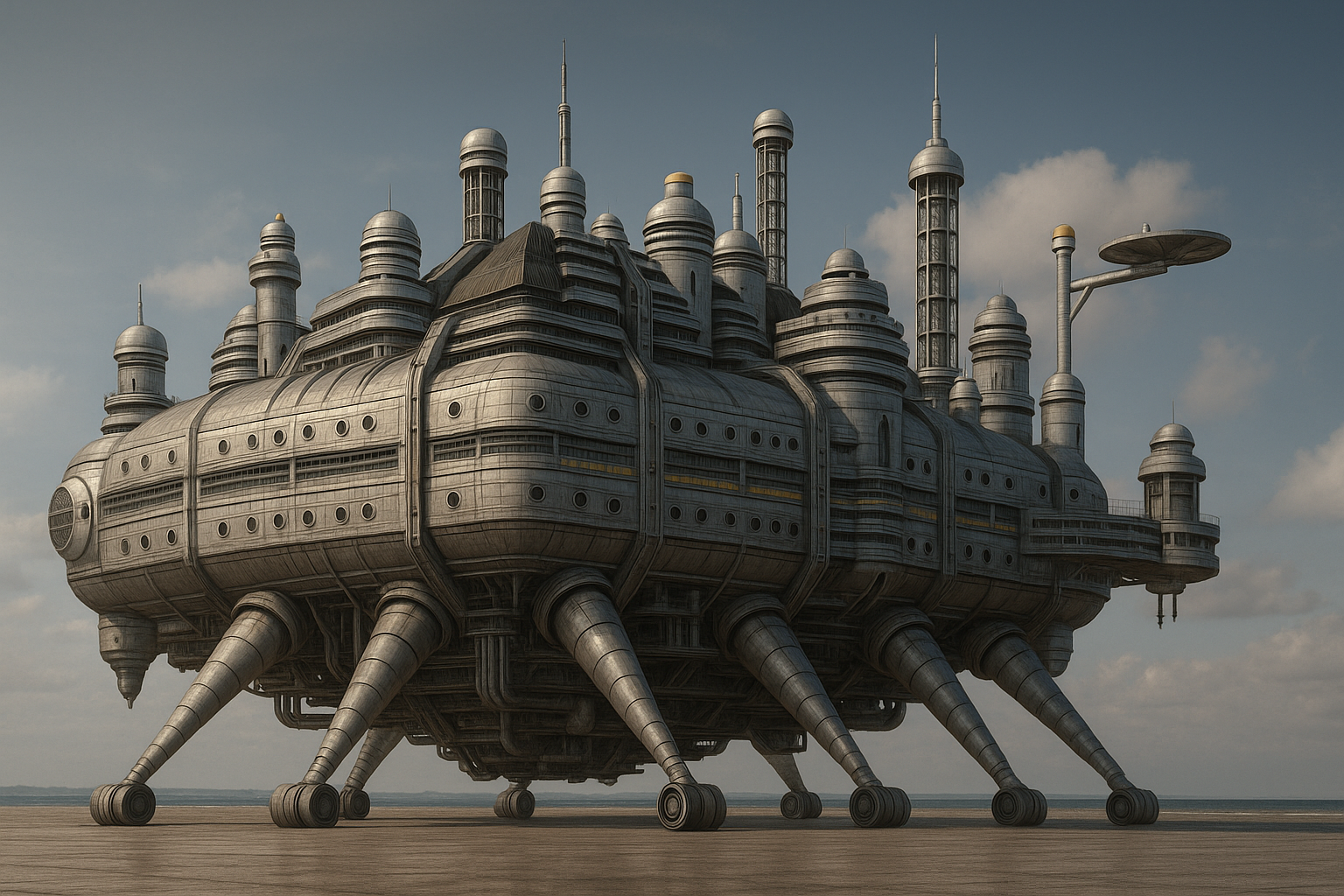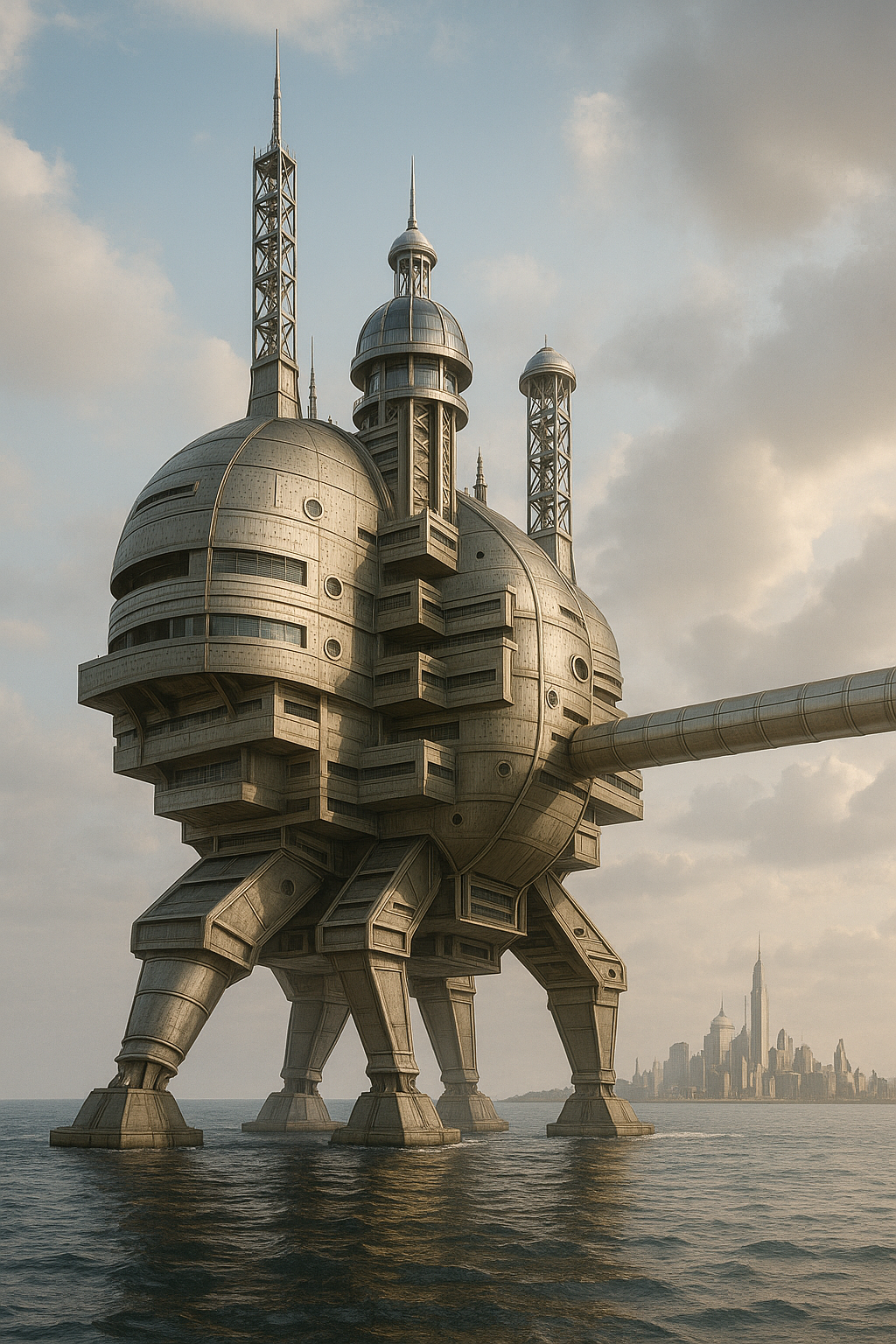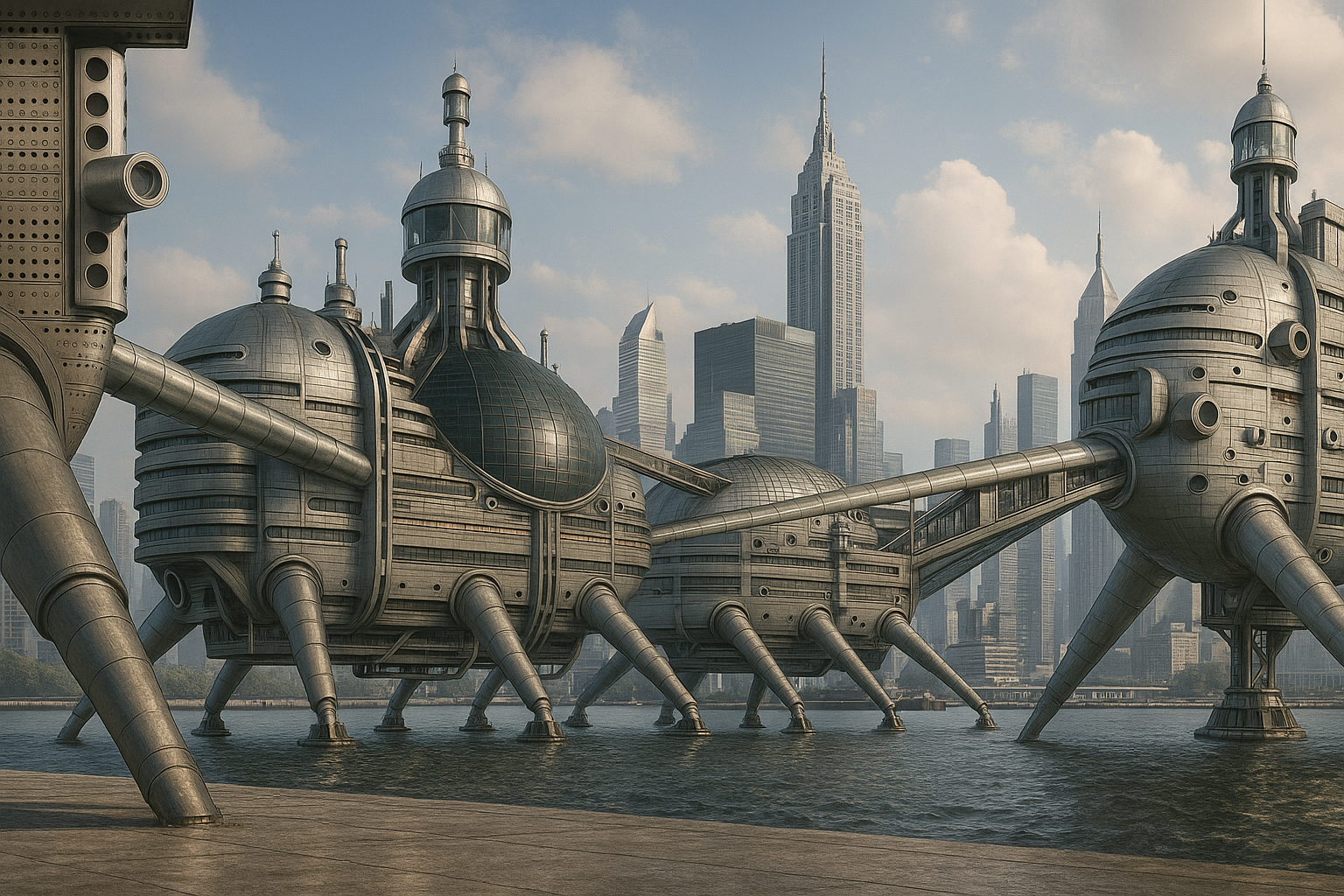Walking City de Archigram (Ron Herron)
Principais características
Prompt positivo: Ultra-detailed 8K architectural visualization, eye-level perspective of the “Walking City” by Archigram, envisioned in 1964. A visionary megastructure emerges — colossal, mobile, and radically adaptable — challenging the permanence of traditional architecture. These monumental walking structures traverse varied terrains, capable of settling over existing cities or even gliding across oceans, redefining the boundaries of urban mobility and territorial occupation.
The Walking City operates as a fully nomadic urban organism. Populations inhabit a constant state of movement, circulating between cities that themselves never remain still. Each unit is a towering, mechanical monolith supported by massive hydraulic legs, enabling locomotion across landscapes with slow, deliberate rhythm.
The structure is composed of clustered modular units arranged across multiple levels, accommodating all functions of urban life — housing, infrastructure, industry, public spaces, and governance. Entire neighborhoods rise vertically within these autonomous capsules, forming self-sufficient vertical cities-in-motion.
Architectural elements include industrial-scale textures: exposed steel joints, matte composite cladding, telescopic structural supports, and articulated mechanical limbs. The aesthetic merges brutalism with sci-fi modularity, rendered with photorealistic detailing.
Natural daylight filters through a dynamic atmosphere — heavy clouds, marine horizons, or post-urban landscapes — depending on the chosen environment. The visual tone evokes Archigram’s techno-utopianism: mobile, flexible, endlessly reconfigurable. A kinetic metropolis built not to settle, but to evolve, roam, and reinvent what it means to inhabit the city.
Prompt negativo: Low resolution, fantasy architecture, post-apocalyptic decay, neon cyberpunk elements, chaotic layouts, symmetrical classical buildings, overgrown vegetation, traditional static urbanism, flat lighting.
Imagens produzidas pelo Chat GPT a partir de entradas de texto
Características formais
Prompt positivo: Ultra-detailed 8K architectural visualization, eye-level perspective of the “Walking City” by Archigram, imagined in 1964. A monumental megastructure composed of nomadic clusters unfolds across the horizon — each unit a colossal, mobile habitat engineered for radical adaptability. These Walking Cities are no longer solitary machines, but replicable urban entities forming vast migrating colonies, mobile agglomerations drifting together across terrain and sea.
Each Walking City stands atop mechanical legs and is clad in a sculptural steel exoskeleton, evoking an armored carapace. Control towers rise vertically from within the structure, crowned by gleaming glass domes that function as observation decks and navigational command centers. These vertical extensions resemble the antennae of insects, projecting from the shell-like form with metallic precision.
Additional towers pierce the structure’s surface, their frames exposed, hinting at the industrial and architectural avant-garde of the 1960s. Small circular windows scatter across the armored shell, punctuating the surface with a rhythmic visual texture. The city functions as a fully mobile and autonomous entity, capable of traversing continents or anchoring temporarily as an island-like construct upon the ocean.
The architecture reflects Archigram’s radical utopian ethos: modular capsules for living and working are embedded into the core of each megastructure, forming self-contained, flexible ecosystems. Photorealistic materials — brushed steel, tinted glass, ribbed aluminum, rubberized joints — are rendered under soft ambient daylight, casting elongated shadows across the mechanical terrain.
The scene captures a speculative vision of mobility and urban adaptability, where architecture walks, migrates, and settles temporarily, embodying the restless and imaginative spirit of the 1960s architectural avant-garde.
Prompt negativo: Low resolution, traditional architecture, classical facades, static cities, post-apocalyptic ruins, chaotic layout, soft fantasy elements, neon colors, nature-dominated landscapes, lack of mechanical detail, overgrown vegetation.
Imagens produzidas pelo Chat GPT a partir de entradas de texto
Características de Infraestrutura de Mobilidade
Prompt positivo: Ultra-detailed 8K architectural visualization, eye-level perspective of the “Walking City” by Archigram, imagined in 1964. This visionary mobile city functions as a colossal vehicular structure — fully autonomous, nomadic, and capable of relocating to any environment. Internally, its circulation system is composed of mechanical ramps, escalators, moving walkways, elevated bridges, and tubular passageways that thread through the structure, organizing pedestrian flow according to speed — slow, medium, or fast.
Externally, each Walking City connects to others via telescopic ramps and articulated corridors, forming an integrated network of mobile urban units. These extendable connectors bridge between structures, roads, railways, and international transportation systems, allowing seamless interconnection and collective mobility.
Each Walking City is equipped with a helipad platform for vertical aircraft, reinforcing its independence and readiness for airborne traffic. The entire megastructure acts as a hybrid between architecture and machine — a city as vehicle.
Architecturally, the surfaces are clad in industrial textures: modular steel plates, mechanical joints, retractable bridges, and perforated metal walkways. Small circular portholes punctuate the facades, while elevated control towers and aerial docking ports rise from the structure like antennae. The mobility logic extends through every layer of the city’s form, from urban systems to mechanical articulation.
Rendered with photorealistic materials — brushed aluminum, matte steel, reinforced glass, flexible joint mechanisms — under ambient natural light with soft industrial shadows. The scene captures Archigram’s kinetic vision of a self-moving, interconnected, and endlessly reconfigurable urban future.
Prompt negativo: Low resolution, traditional buildings, static cities, historical architecture, post-apocalyptic settings, broken structures, fantasy elements, overgrown nature, lack of mechanical parts, disordered composition, neon cyberpunk tones.
Características Espaciais e Funcionais
Prompt positivo: Ultra-detailed 8K architectural visualization, eye-level perspective of the “Walking City” by Archigram, imagined in 1964. A colossal nomadic city-machine unfolds before the viewer — an immense mobile structure traversing landscapes with mechanical precision. Each Walking City is autonomous and multifunctional, but within the network, each one specializes in a distinct urban function: one is dedicated to habitation, another to governance and administration, another to entertainment and culture, another to essential services, and another to healthcare and medical infrastructure.
Together, they form a coordinated constellation of specialized mobile cities — a flexible and modular urban ecosystem in constant motion. The walking structure rises on hydraulic limbs, its metallic exoskeleton encapsulating high-tech capsules arranged by use.
Architectural volumes are modular, functional, and deeply expressive of the avant-garde aesthetic of the 1960s: aerodynamic capsules, stacked units, protruding platforms, and technical towers punctuated with antennas and observation domes.
Surfaces are clad in photorealistic materials — steel panels, reinforced joints, circular porthole windows, and matte mechanical plating — rendered under soft natural daylight with sharp shadow detailing. The image captures Archigram’s radical vision: the city as a machine, fully mobile, functionally specialized, and perpetually reconfiguring the urban condition.
Prompt negativo: Low resolution, traditional architecture, fantasy elements, fixed cities, post-apocalyptic ruins, chaotic organization, neon lighting, nature overgrowth, historical or classical buildings, lack of mechanical detailing.
Imagens produzidas pelo Chat GPT a partir de entradas de texto
Todos os prompts anteriores.
Prompt positivo: Ultra-detailed 8K architectural visualization, eye-level perspective of Archigram’s “Walking City,” envisioned in 1964. A visionary megastructure — colossal, mobile, and radically adaptable — defies the permanence of traditional architecture. These monumental walking machines traverse diverse terrains, capable of installing themselves over existing cities or gliding across the ocean, redefining the limits of urban mobility and territorial occupation.
The Walking City functions as a fully nomadic urban organism. Populations live in perpetual movement, circulating between cities that never remain still. Each unit is a towering mechanical monolith supported by massive hydraulic legs, moving with a slow and deliberate rhythm across varied landscapes.
Its structure is composed of modular units organized in vertical tiers, housing all essential urban functions — residences, infrastructure, public services, industry, governance, and culture. Entire neighborhoods are vertically integrated within autonomous capsules, forming fully self-sufficient vertical cities in motion.
The architectural language draws from the industrial and avant-garde aesthetics of the 1960s: exposed steel joints, matte composite cladding, telescopic structural supports, and articulated mechanical limbs. Surfaces are clad in photorealistic textures — brushed steel, ribbed aluminum, circular porthole windows, reinforced glass, and rubberized joints.
Command towers rise from the megastructure, crowned with reflective glass domes used for observation and aerial navigation. These vertical extensions resemble insect antennae, further enhancing the mechanical-organic hybrid quality of the design. Additional control spires pierce the carapace-like shell, suggesting a futuristic yet industrial skyline.
Internally, movement is managed by mechanized ramps, escalators, moving walkways, elevated bridges, and tubular corridors, all organized by speed: slow, medium, and fast. Externally, telescopic ramps and articulated connectors link Walking Cities together, forming a continuous network of mobile urban units. These connections integrate seamlessly into global infrastructure — roads, railways, and communication systems.
Each Walking City includes a dedicated helipad platform, reinforcing its autonomy and aerial accessibility. The city itself becomes a vehicle — not only mobile but functionally specialized. Within the greater constellation, each city assumes a distinct role: one for habitation, another for administration, others for health, services, entertainment, or logistics — forming a modular and coordinated ecosystem of nomadic urban machines.
Natural daylight filters through a dynamic atmosphere — oceanic horizons, post-urban terrain, or dramatic clouds — enhancing the speculative mood. The overall composition embodies Archigram’s techno-utopianism: mobile, flexible, and endlessly reconfigurable. A kinetic metropolis designed not to settle, but to evolve, circulate, and reinvent what it means to inhabit the city.
Prompt negativo: Low resolution, static architecture, historical or classical styles, overgrown vegetation, post-apocalyptic ruins, fantasy elements, neon lights, broken geometry, chaotic layout, lack of mechanical components, futuristic sci-fi spaceships.
Imagens produzidas pelo Chat GPT a partir de entradas de texto
